















The first step in creating a flower is to generate a petal. The shape of a petal is not complex and has symmetry, so it can be seen as a geometric plane. In TouchDesigner, there are various ways to generate such a plane using a spline curve to create a contour and then using the Poly algorithm to create the plane.
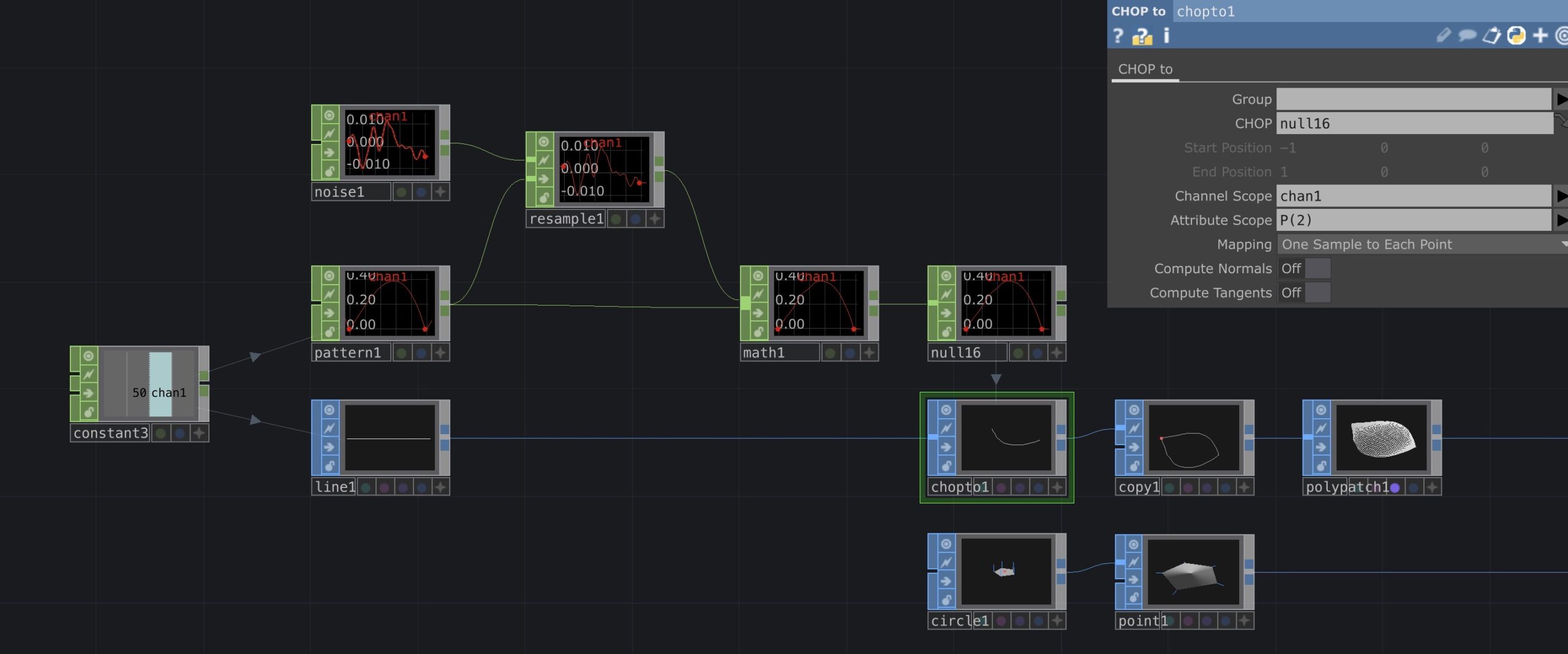
To generate a spline curve, the Line SOP is used to create a curve with a desired number of segments. The curve is then created by modifying the coordinates of each point on the spline, so it is necessary to ensure that the initial spline has enough segments. The curve spline is generated using the geometry attributes value (Attribute) modification method in SOP, which can be achieved by using the Chop to SOP. In this case, the Pattern Chop is used to generate the curve spline as shown in the image.

https://docs.derivative.ca/Attribute
Next, the Copy SOP is used to make a symmetric copy of a single curve spline, creating a closed spline curve with a petal shape. To convert the closed spline curve into a plane, the PolyMatch SOP is used. This SOP can use various geometric surface calculation methods to convert the closed spline path into a plane, where the level of detail of the plane can be defined. Thus, the petal is formed.
The final step is to add some curvature to the rigid petal by using the Twist SOP, which gives it a more natural appearance. After completing these steps, the geometry allows us to reuse the geometry and modify its appearance programmatically, which is one of the key benefits of procedural modeling.
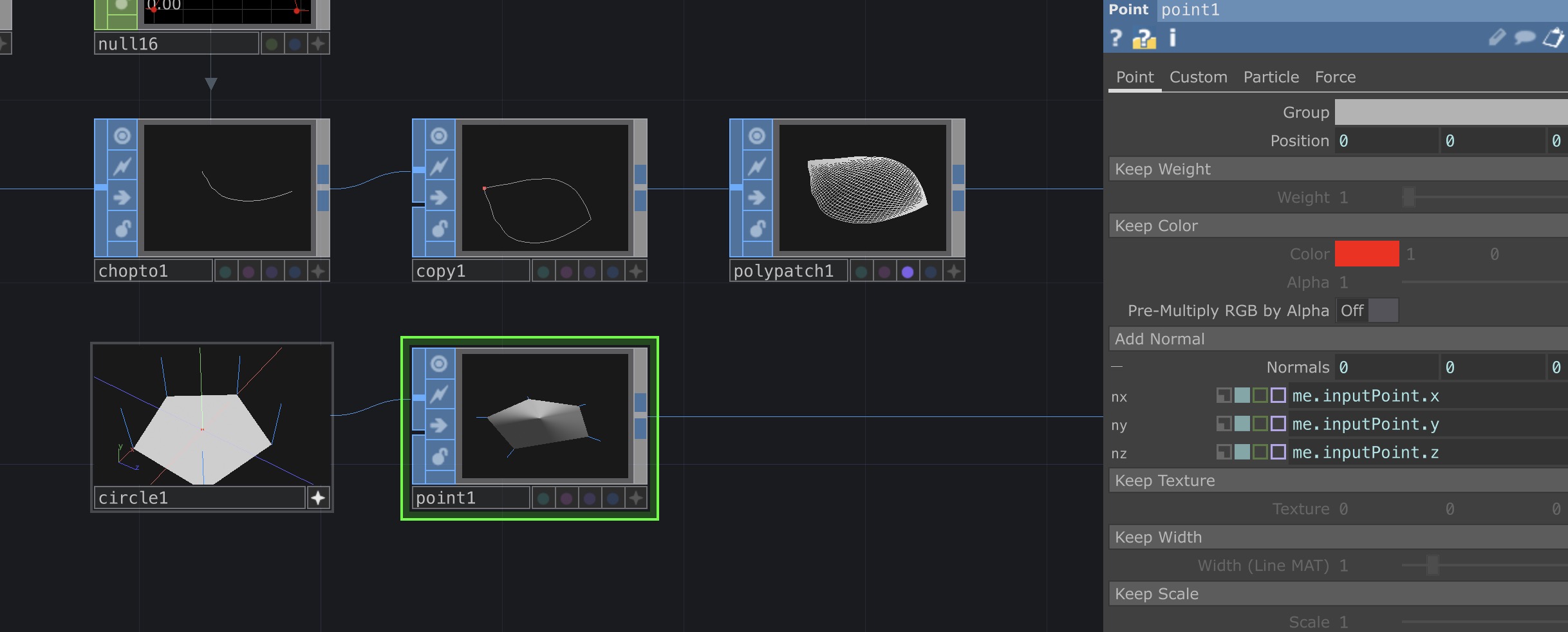
I need a reference data source for replication – the receptacle. In my assignment I used overlapped circle rings of various sizes (circle SOP) as my reference data for petal instantiation. The coordinate data of each geometry point (Points) on the circle is the position reference of the petal, and the normal data is the orientation reference of the petal. In addition, Scale (size) attribute values are defined and added to the circle to control the size of each layer of petals, as well as Color attribute values to control the color of the petals on each layer of the circle. When defining the basic circle, there is a problem that the normal direction at each point on the circle is not radiating like real petals, but all vertical. Here, I use Point SOP to redefine the direction of the normal to make the normal direction perpendicular to the tangent of each geometry point’s location, and the normal direction can be controlled later to control the opening and closing of the petals. I used the Point SOP to reorient the normals of the base circle so that they are perpendicular to the tangent at each point on the circle. This allowed me to control the opening and closing of the petals by manipulating the direction of the normals.

After completing the procedural modeling of the flower, we can start building a rendering pipeline for rendering the scene. To make the flower look less stiff and rigid, we can use the Noise SOP to affect the orientation of the petals, creating the effect of wind disturbance. Additionally, because we want the color of the flower to signify that it is a digital flower, it is not necessary to create a fully realistic effect. For the color of the petals, we use noise and disable its monochrome effect, resulting in a colored effect. Then we map it to the environment, which reflects directly onto the flower itself.
This project utilizes the custom-built component AudioAnalysis Pro. Attached below is the authorized AudioAnalysis file (compatible only with version 2022), which is more user-friendly and easy to connect with other components than the original version. It also fixes a bug in the software activation interface. This component has greatly helped in the development of my visualization project.
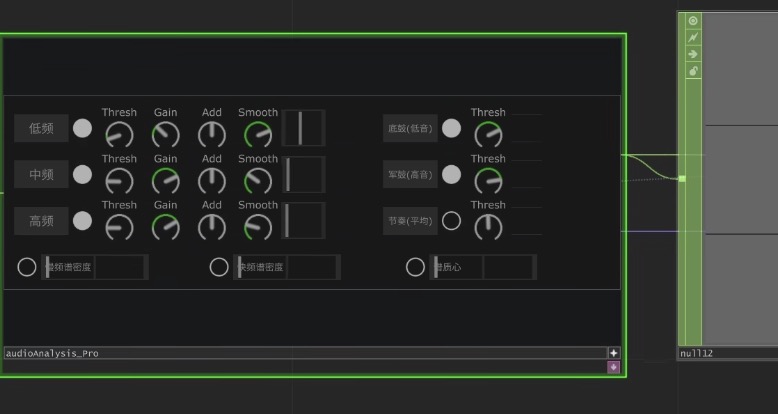
When adding audio to the visualization, you can use the AudiofileinCHOP to add a file or the AudioDevicelnCHOP component to input real-time microphone audio. For my project, I used a simple PBR material without any texture maps. I added a metallic sheen to the material to give it a more futuristic, high-tech feel.
I also created a wireframe material using the LineMAT component and adjusted some parameters. I used a Switch to toggle between the normal material and the wireframe material based on the music. I created the background using the BlurTOP component, using the simplex3D function of noise to adjust it.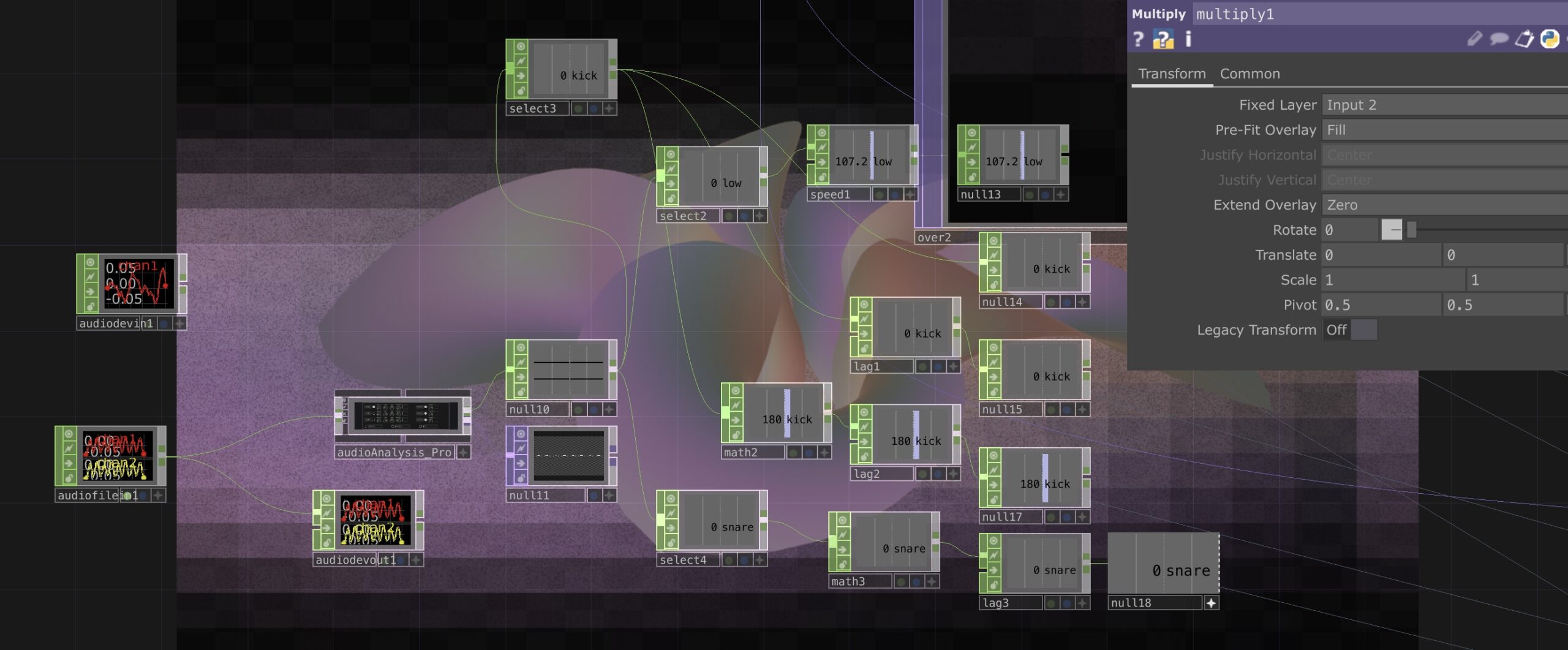
Finally, I bound the specific effects of the AudioAnalysis component to my visuals through mapping and data normalization. For example, the kick is bound to the wireframe material and the rotation speed is increased when there is a kick in the music. I tested my project using low-frequency music, but the final effect will be adjusted based on the music used, which has a lot of high-frequency sounds. Oh, by the way, I added an oscilloscope which makes it easier to see the effect.

As you can see, I put a lot of effort and creativity into my visualization project. I incorporated so many different elements, from the 3D modeling of the flower to the use of audio analysis to create dynamic visual effects. I really care about the feel of the project and I think it is a well-crafted and engaging piece of work.
We wanted to connect the interactive device to a video player and audio, and after exploring this we found that we could use touch designer to connect the arduino to the video and audio and control the audio and video playback through the interactive device.
STEP
1.Connect the Arduino board and pressure sensor: Connect the pressure sensor to the Arduino board, and then connect the Arduino board to the computer.
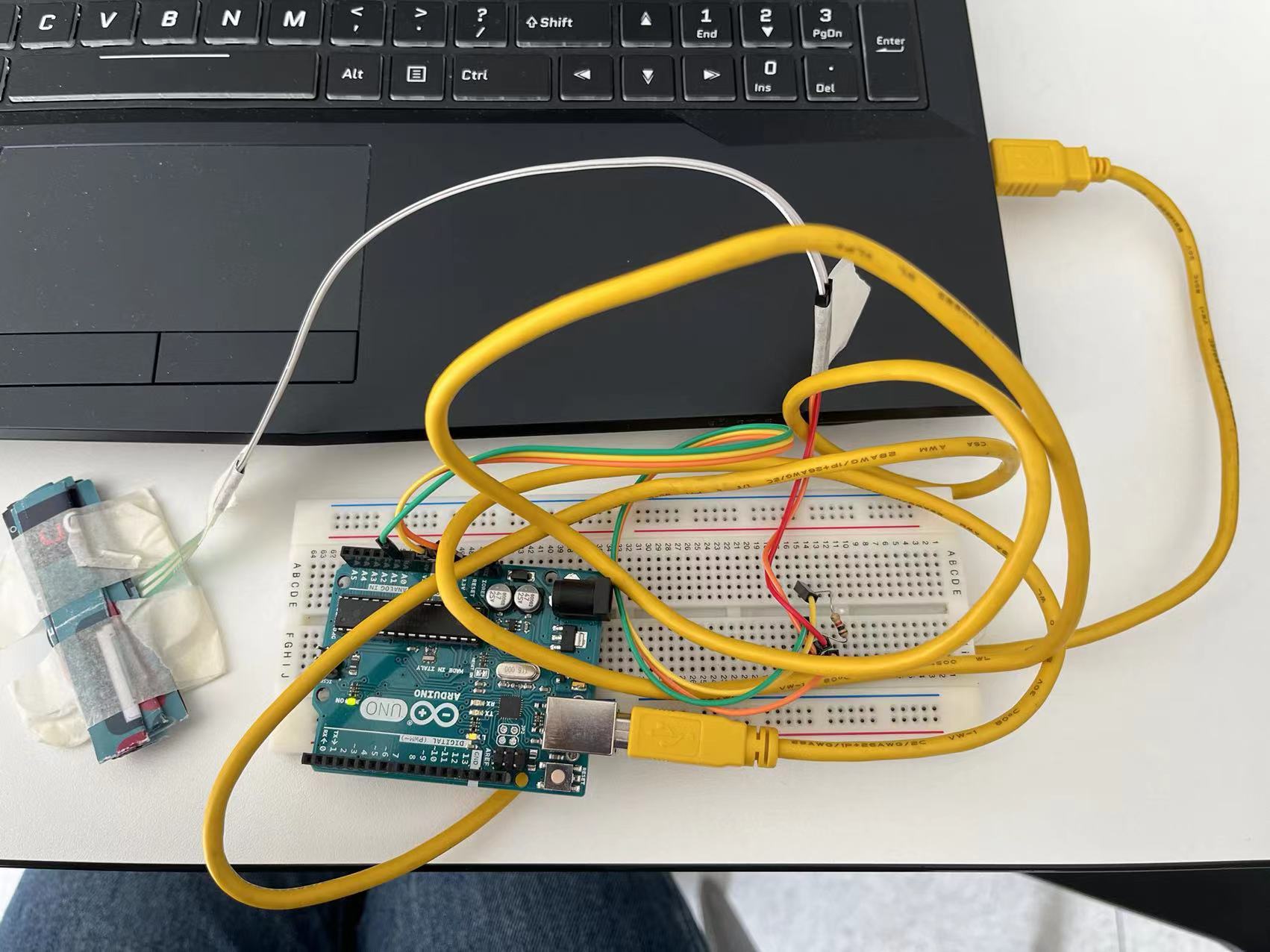
2.Write an Arduino program: Use the Arduino development tool to write a program that reads data from the pressure sensor and transmits the data to the computer.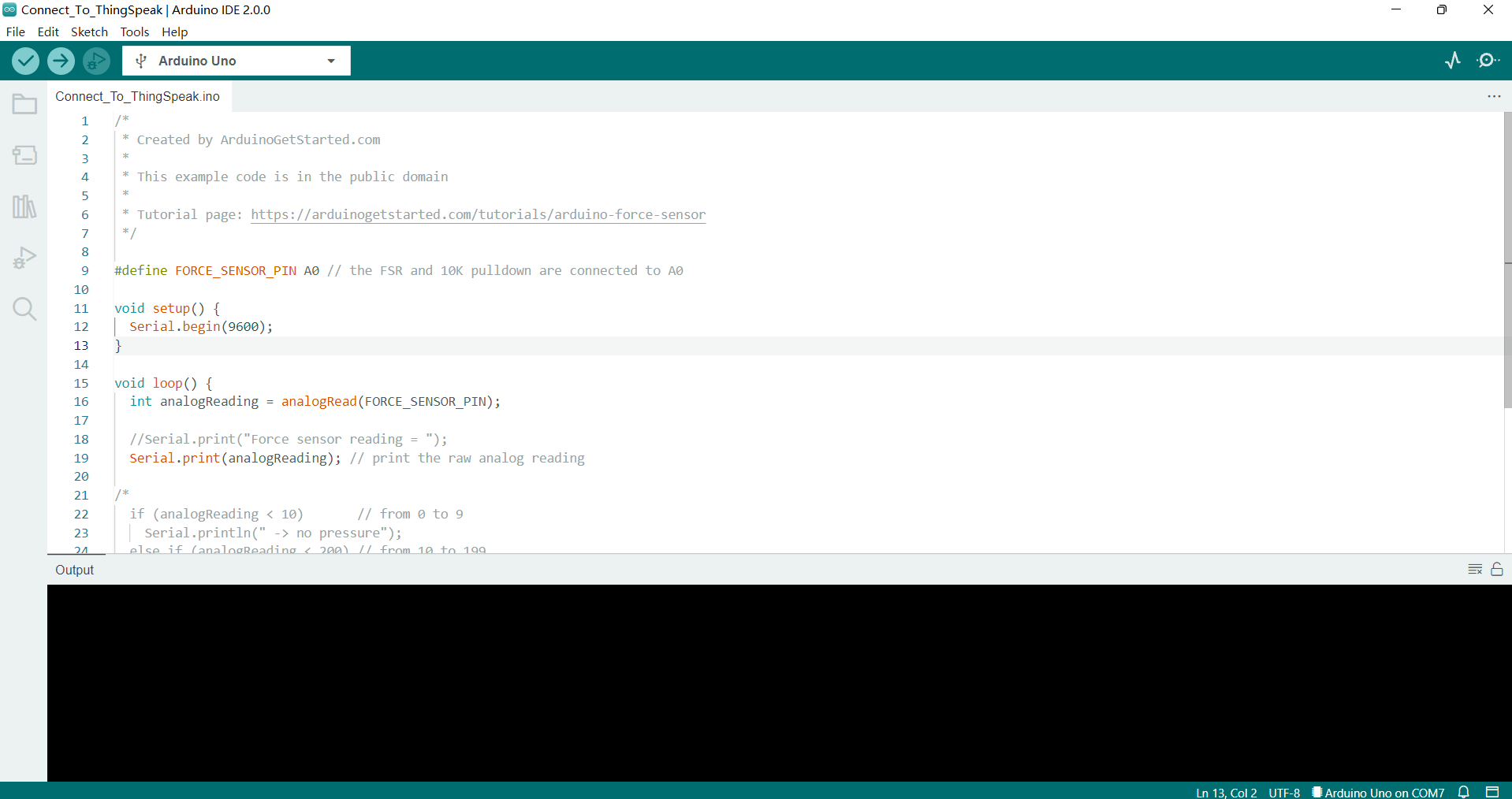
3.Install Serial DAT: In TouchDesigner, install the Serial DAT component, which can receive data sent by the Arduino board.
4.Configure Serial DAT: In TouchDesigner, configure the Serial DAT component to communicate with the Arduino board. The serial port and baud rate parameters need to be specified.
5.Create a trigger: Use the CHOP component in TouchDesigner to create a trigger that can receive data sent by the Serial DAT component and convert the data into a signal that can be used to control the speed of video playback.
6.Control the speed of video playback: Use the Movie File In component in TouchDesigner to import a video file, and use the trigger to control the speed of video playback based on the data received from the pressure sensor.
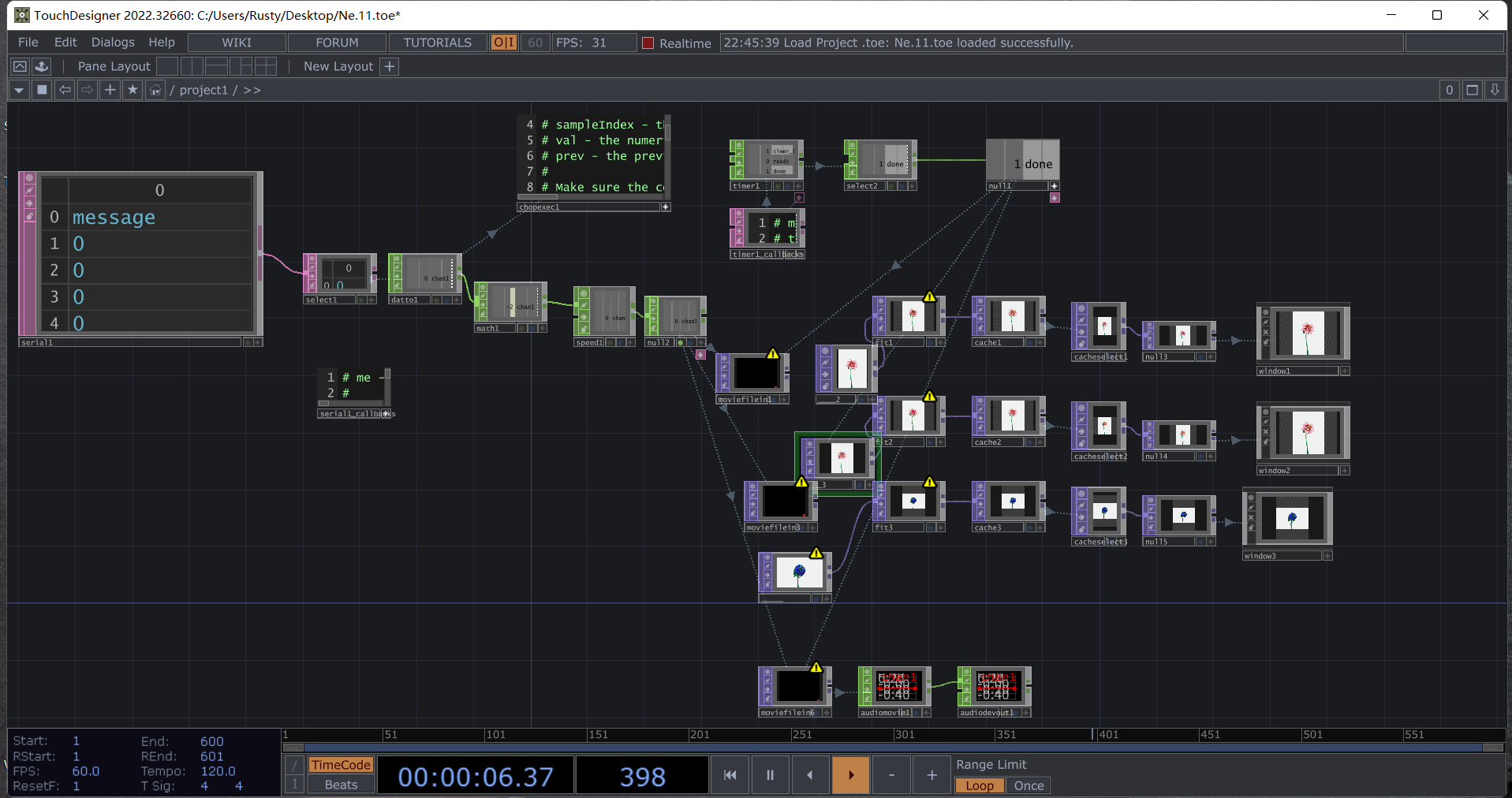
7.Connecting device

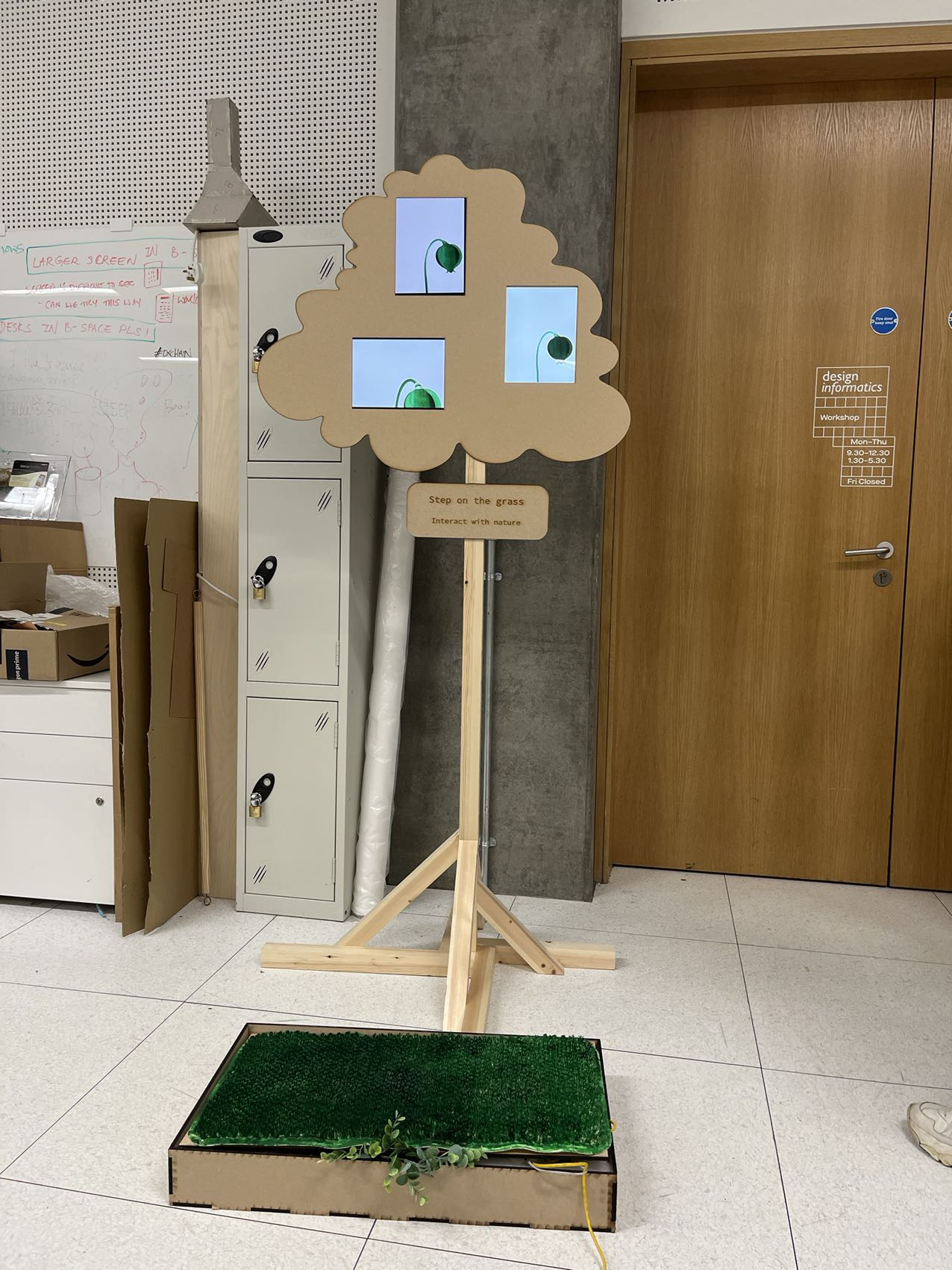
Reference
Although we understand the space (E15A) for the presentation is not that big and neat enough for our installation, we still choose the room for our update project. That is because there are several rooms booked for the degree show such as C09, C02, and other rooms such as C08 and E21 are not available during the spring vacation. Therefore, we used a large black curtain to cover the floor.
A possible future improvement would include a more suitable room for the audience to walk around. At the same time, it is necessary to be well-lighttight for projection and proper size for filling the room with music.
We expect to find a room large enough in the future that the projections of water ripples and the interaction of the touch designer can fill the room. Max is still capturing the movement of the characters, but these changes will present a more dramatic visual change. The changes made to the image by the characters will become more visible
The current installations appear too crude and in the future, we can improve the visual effect in terms of the beauty of the installations, the neatness of the environment and the refinement of all aspects.
Although we enriched the interactive way, the experiences still be regarded as insipid. In this case, it would be better to make two video walls interactive rather than just videos with masks. For example, the audience can be captured as a human mask.
As well as this, the current interaction is still between the person and the wall, and the person and the installation, we want to make it so that the movement of the person has an effect on the whole room. For example, when people walk on the floor, the floor will ripple as they fall; the water ripples on the walls will change as more people talk in the room, the volume of sound, etc.
We expect the future of interaction to be a dual interaction between people and people and people and things.
We have updated another piece of music, but the main part still be remained. The original piece is generated for the vibration of water, so it tends to have a strong sense of rhythm. It would be better if we change the style and atmosphere from sci-fi music to sound conveying pleasant and peaceful.
We have been working on this problem for a long time, but the final effect was still not satisfactory. Apart from the introduction before watching and the explanation from us, the designers, it seems to be difficult for the audiences to understand what we want to convey and the metaphor for each piece of content. In the future project, we would prefer to learn from more projects which can be easily understood.
Preface
Once upon a time, Edinburgh was a bustling city filled with people and buildings. But after a catastrophic event, the city was abandoned, and nature began to reclaim its land. Years went by, and Edinburgh transformed into a lush, green jungle. The streets were overgrown with vines and tall trees, and the buildings were slowly crumbling away. But amidst the chaos of nature’s takeover, a new form of life emerged. Plants, once relegated to the parks and gardens of Edinburgh, now thrived in every corner of the city. Giant flowers bloomed in the ruins of buildings, and trees reached towards the sky, creating a lush canopy above.
Animals, too, had returned to the city. Deer and foxes roamed the streets, and birds nested in the trees. The sound of their calls filled the air, a symphony of life that had been missing from Edinburgh for so long. But those who ventured into the city had to be careful, for the plants had grown wild and unpredictable. Some had evolved to defend themselves, and their thorns could prove deadly. But for those brave enough to venture into the heart of Edinburgh, they were rewarded with stunning sights of nature’s beauty. And so, the city of Edinburgh became a place of mystery and wonder, a testament to the power of nature and the resilience of life. The ruins of the past served as a reminder of what once was, while the thriving jungle was a symbol of hope for the future (ChatGPT, 2023).
Introduction
In our Digital Media Studio project, we embarked on a captivating journey to investigate the realm of potential plant mutations and their prospective transformations in the future. Our team collaborated with a range of AI tools, such as ChatGPT, Midjourney, and DALL-E, to generate a series of enthralling sequences that offer unique insights into the possible evolutionary pathways of various plant species.
At the heart of this project lies the core theme of “Process,” which emphasizes the significance of human-AI collaboration in the creative journey. By leveraging the power of these cutting-edge tools, our team was able to explore and expand upon the intricate possibilities that lie within the plant kingdom. This submission highlights the various steps undertaken to bring these extraordinary visions to life, showcasing the seamless integration of human intuition and artificial intelligence.
The project is showcased using a diverse range of media, reflecting our commitment to innovation and providing an immersive experience for our audience. By incorporating projectors, tablets, Arduino-based systems, and Looking Glass panels, we have harnessed the potential of these new-coming technologies and furthermore emphasize interactivity to foster an engaging and memorable experience for our visitors. The combination of hands-on learning opportunities and interactive components encourages attendees to actively participate in the exploration of plant mutations and their potential future developments. This approach not only deepens their understanding of the subject but also sparks curiosity and fosters a greater appreciation for the complexities and beauty of the natural world.
Our process
Our project started by initiating an in-depth engagement with the advanced language model ChatGPT, to explore and better understand the potential ways in which plant species might evolve and undergo genetic mutations in a diverse range of environmental conditions. We sought to gain insights into the complex adaptive mechanisms that plants may employ to ensure their survival and prosperity in the face of ever-changing ecosystems and environmental pressures.
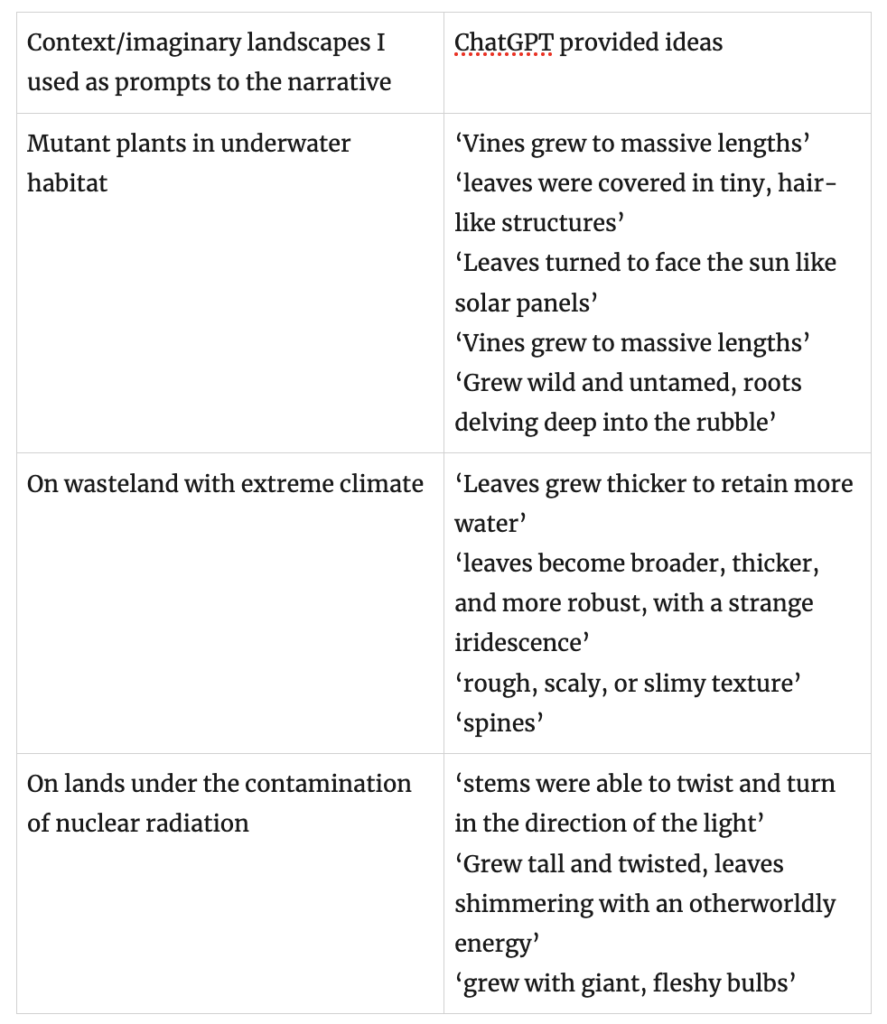
Following the creation of a compelling narrative with the help of ChatGPT, our team delved into the exciting process of visualizing and presenting the plant mutations in the most engaging and thought-provoking manner. We aimed to capture the essence of the story and the unique characteristics of the mutated plants through various visual concepts and media.
After carefully considering the numerous artistic styles and media options, we narrowed down our selection to several distinct methods of presentation, each chosen to best encapsulate the plant mutations and the narrative that accompanies them:
Softwares and Platforms:
TouchDesigner
Maxmsp
Unity
Final materials
AI Sequences and interactivity setup
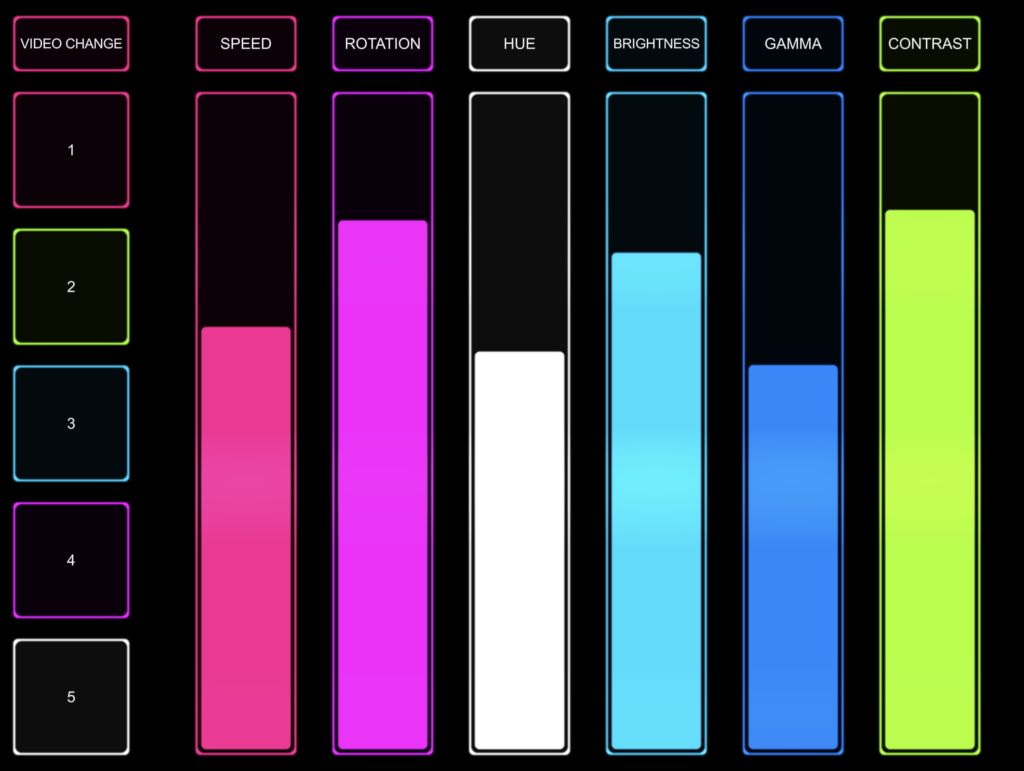
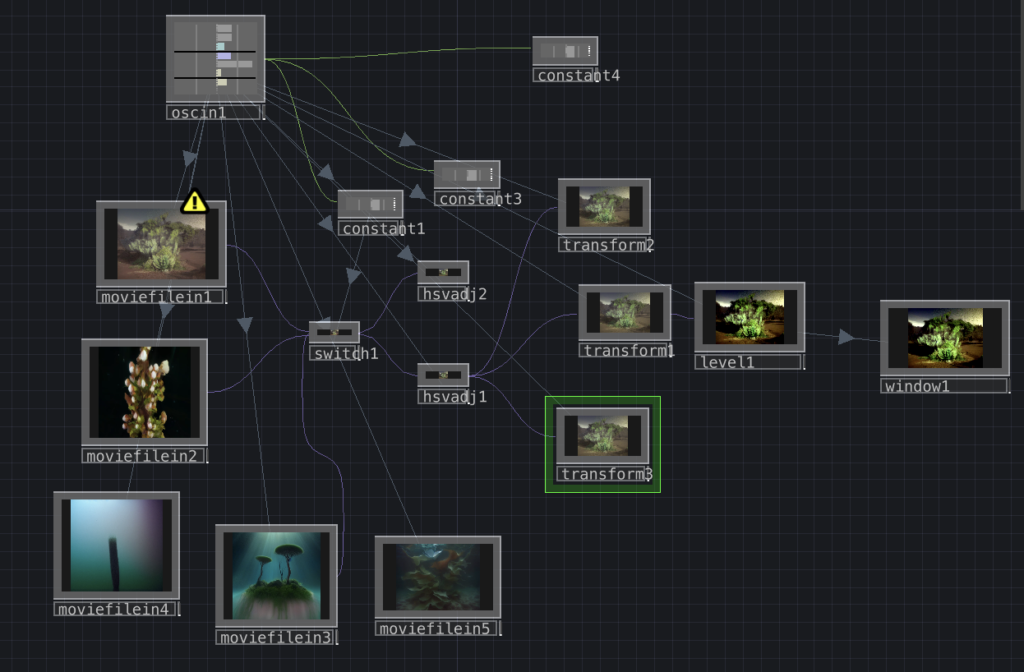
Further Reflection
Under the relationship between people and the environment deduced by artificial intelligence Chat GPT, other members of our team also conducted in-depth exploration from another perspective. Using a flower as a medium, think about the relationship between people and the environment.


Through a series of interactive exhibits and activities, it aims to demonstrate the ways in which humans affect plants and promote a greater sense of responsibility for plant care and conservation.
Sound collection stage: (Chen Boya/Wu Yingxin/Liang Jiaojiao/Li Weichen)
In the early stage of design, our team rented sound collection equipment, went out to Dean Village and around Edinburgh to collect sound materials, and used the sound materials in the sound design part.
Device: AAA Rechargeable Batteries Zoom - H6 Zoom - H6 Accessory Pack 3.5mm Male to 1/4" Female Jack Adapter - 22698 Beyerdynamic - DT 770 PRO 250 OHMS - 6912 Beyerdynamic - DT 770 PRO 250 OHMS - 34224

In the process of going out to explore, we observed the growth status of different plants in the natural environment, and used sound collection equipment to capture the sounds of different plants and environments. From the initial sound of wind and water, birdsong, and tree branches rubbing, to vehicles, buildings, etc., they all have sounds. Inanimate or animate, all are making their own voices. We also use sound as an important sense to perceive the world.

In this process, our team members not only gained a lot of new knowledge, such as sound collection. At the same time, after being exposed to natural sound collection, we have re-recognized nature and are constantly thinking about the connection between man and nature.
For other details, please move to the personal report of the sound engineer. 》》》
Interactive Exploration Stage: (Chen Boya/Liang Jiaojiao/Wu Yingxin)
Device: Looking Glass Leap Motion Controller Performance Laptop
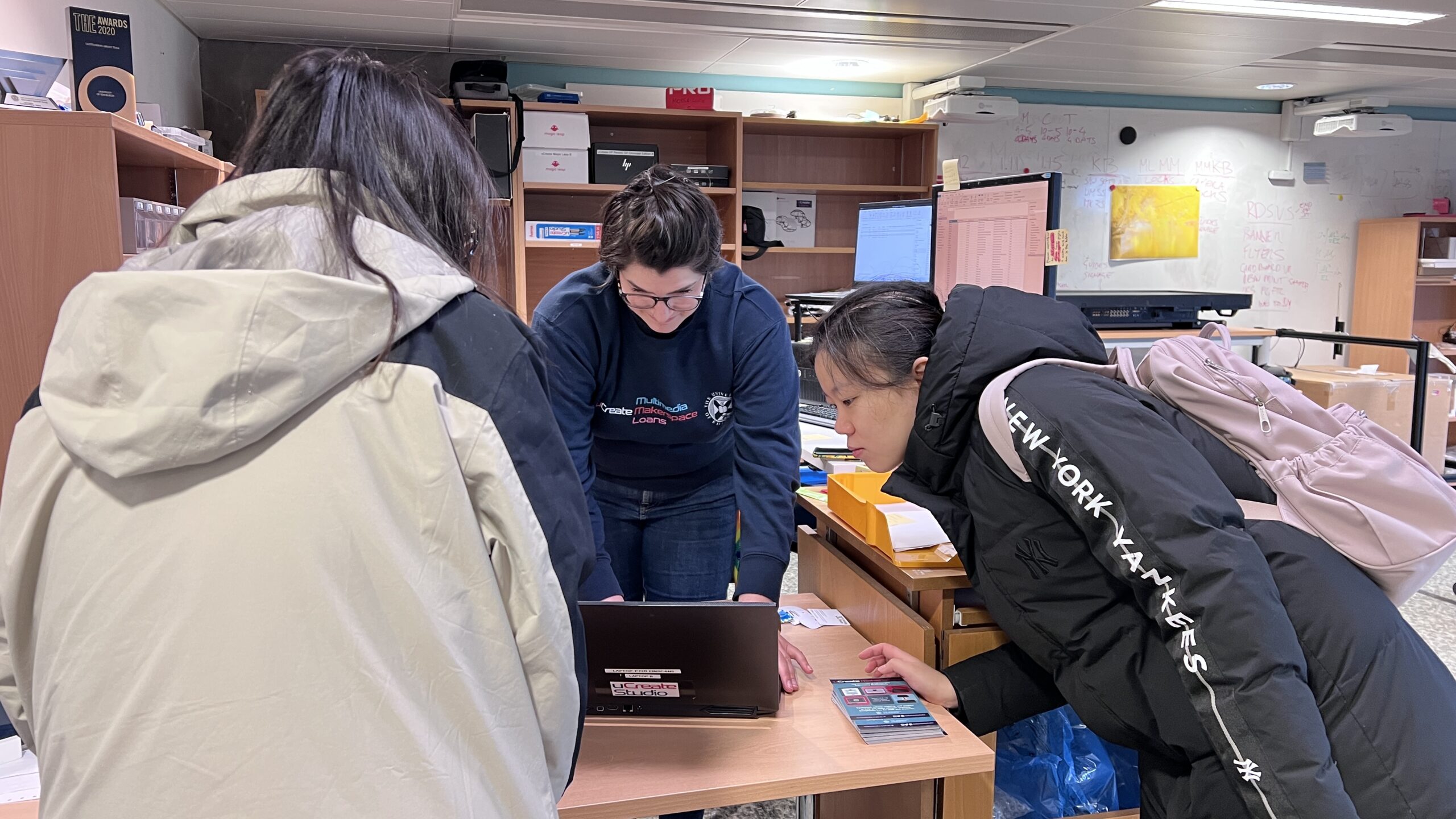
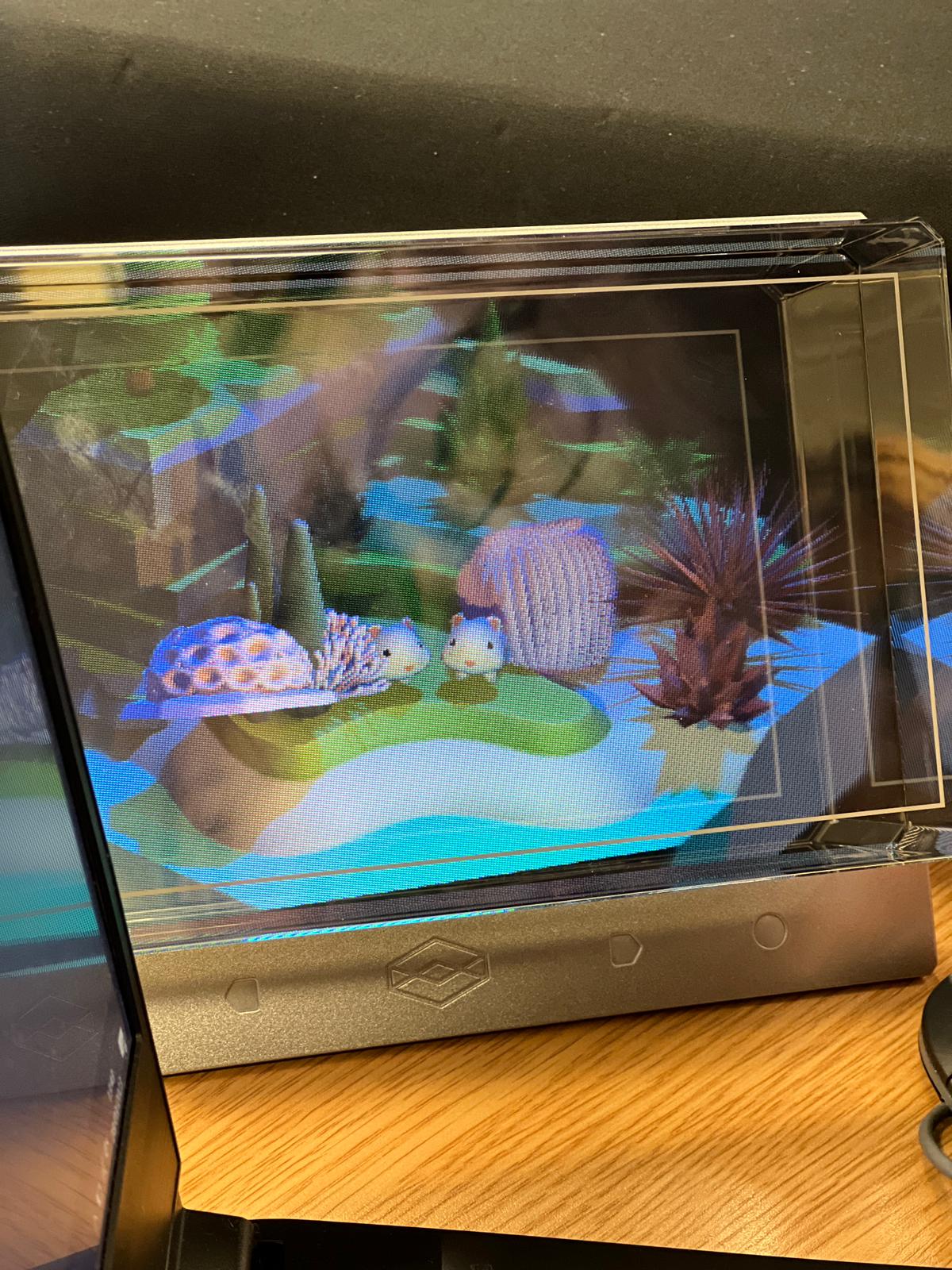

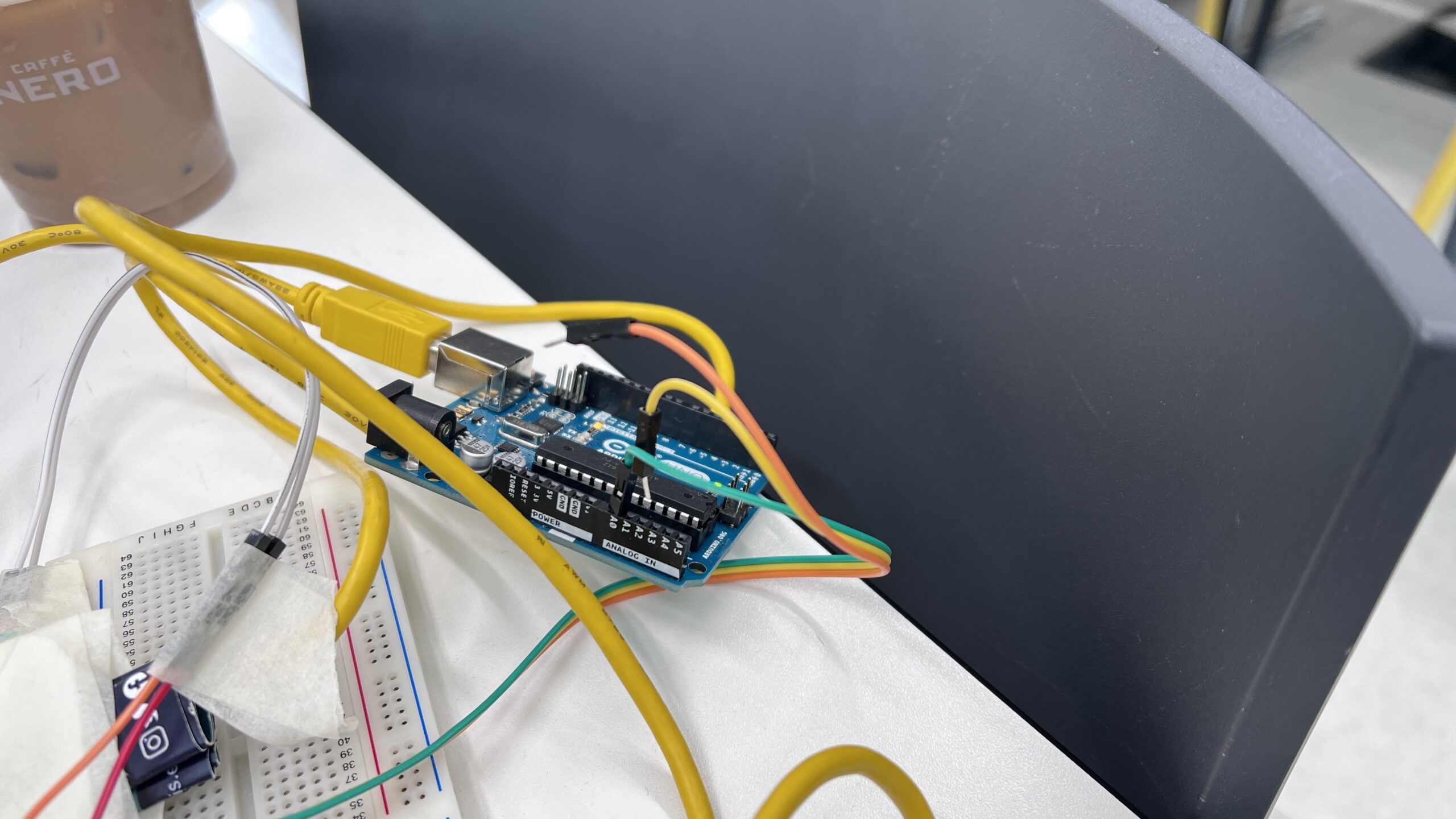
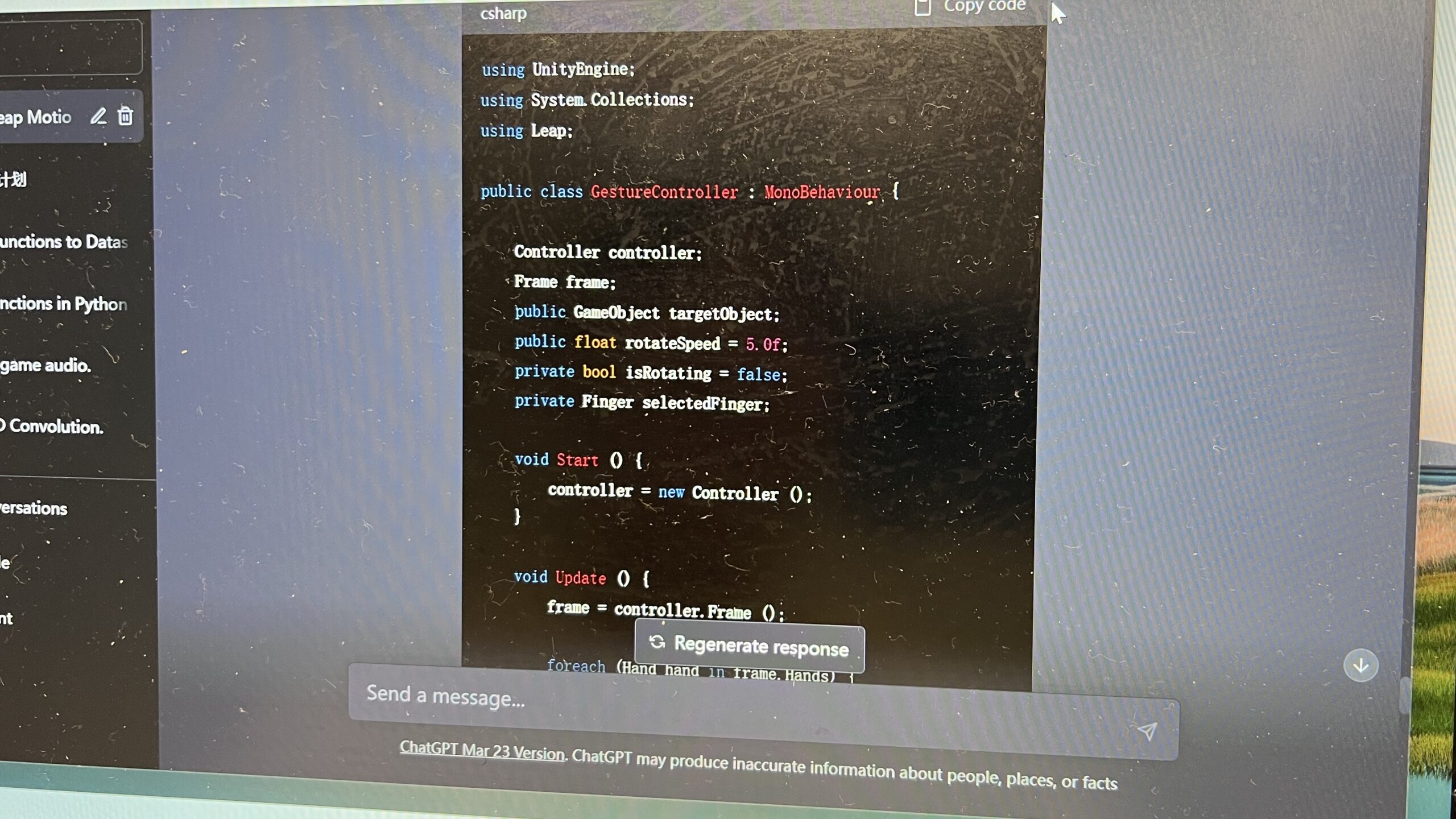
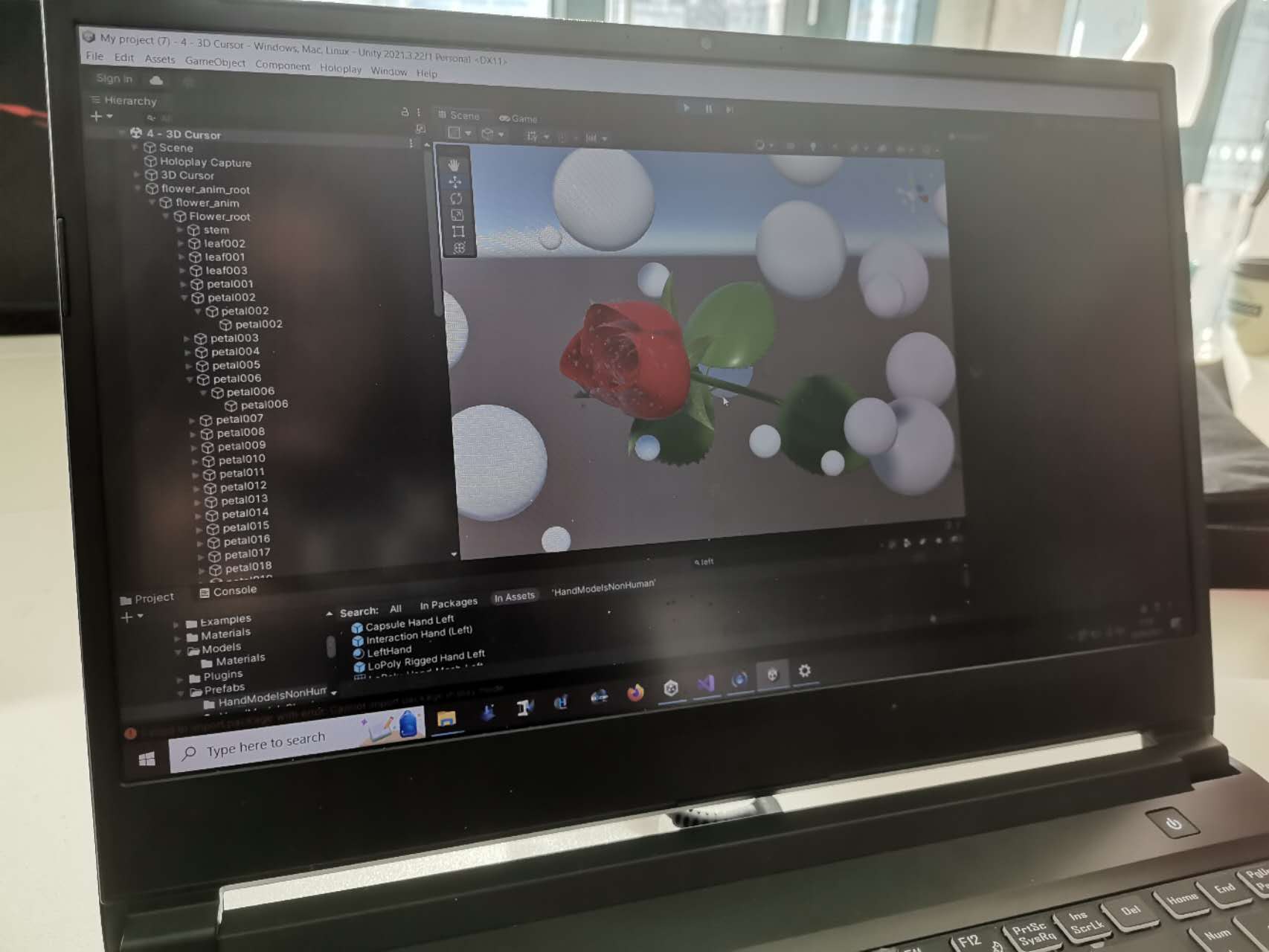

Materials and production: (Chen Boya/Wu Yingxin/Liang Jiaojiao/Li Weichen/Dominik)
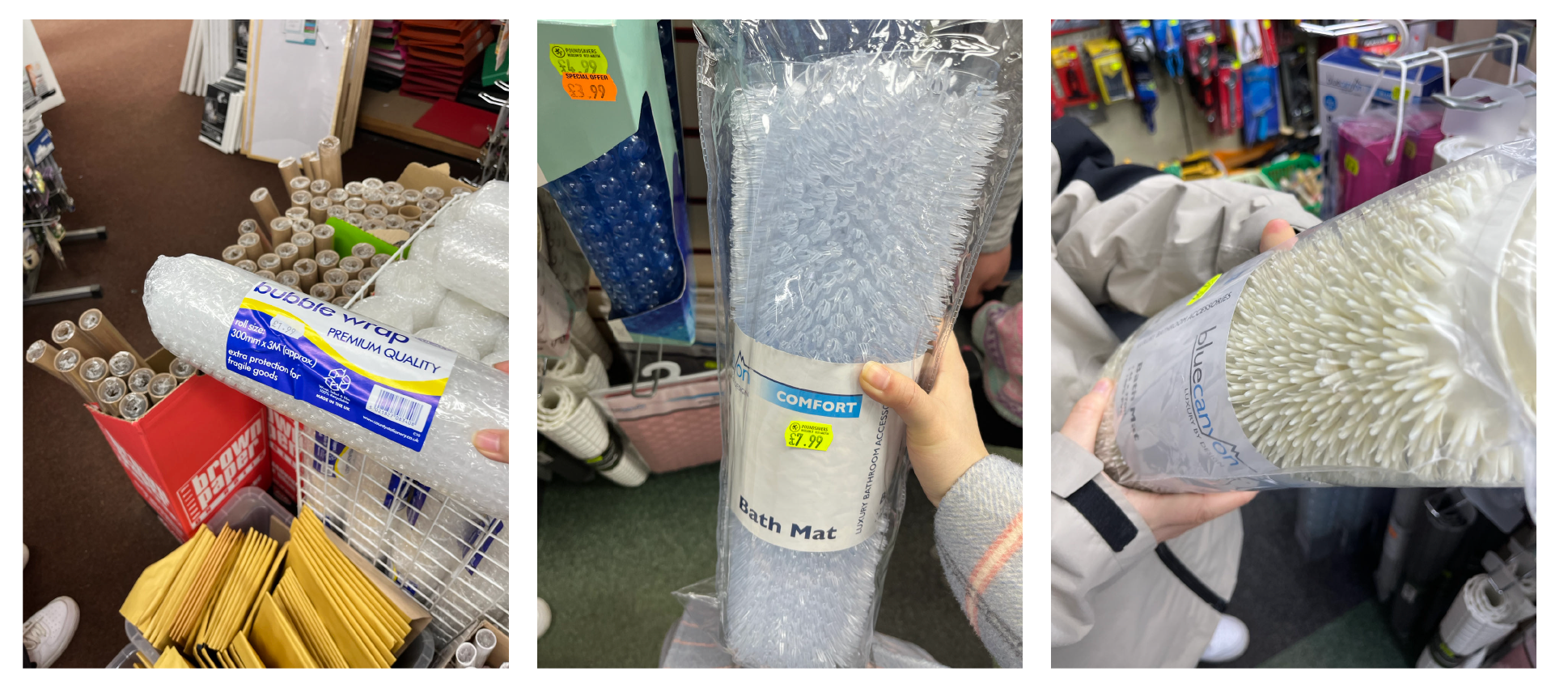


Visualization(Yingxin Wu)
Maxmsp: I have taken a course about max which made me have a basic understanding of the function of max, while listening to a course about maxmsp taught by my professor of this course, I first considered using max at the beginning.
The iteration of the visualization has gone through countless versions. This report mainly explores the parts that have been modified after the pre》
Then I realized that it is difficult to modeling a program programmatically which is not be visualized enough. Especially when the teacher suggested that we could use the same element such as a flower to connect our logic to make our exhibition clearer.
So how to create a flower?
I refer to the following video:
To be honest, I didn’t know anything about Touchdesigner before.
The first step in generating a flower is of course generating a petal. The shape of the petals is not complicated and has symmetry, which can be regarded as a geometric facet> There are many ways to generate such a patch geometry in Touch. Here, the spline is used to generate the patch outline, and then the poly algorithm is used to generate the patch.
Through this attempt of procedural modeling in TouchDesigner, I success. Components such as Copy SOP, Chop to SOP, Point SOP, and Group SOP are commonly used components for procedural modeling. Of course, there are other components that are not involved in this case.
Back to the flower itself, the growth of the plant and the opening of the flower are extremely delicate and wonderful, and the geometric structure of the plant is also very fascinating.
In terms of visualization, I used a more usable component that was modified by someone else authorized.
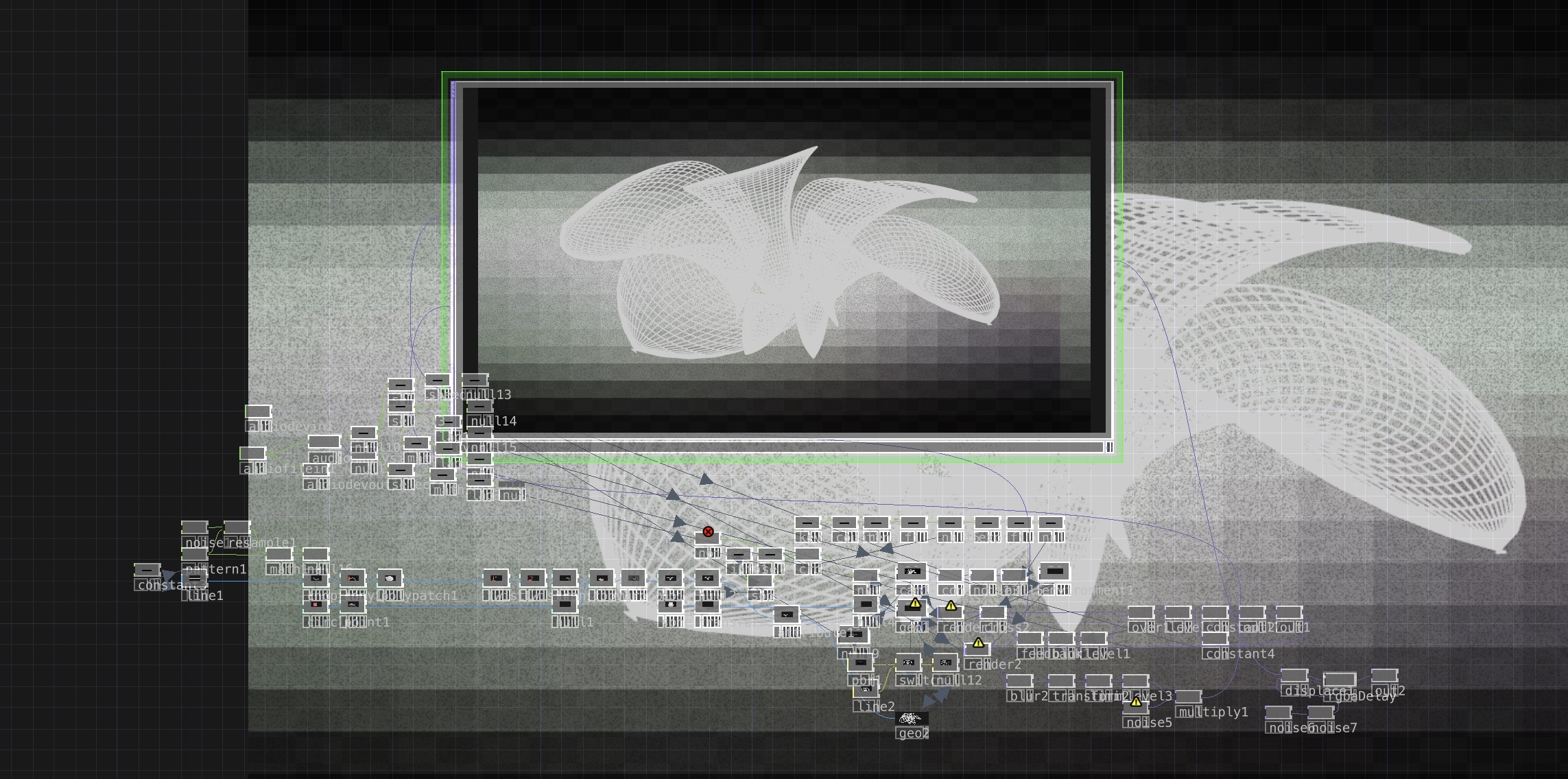
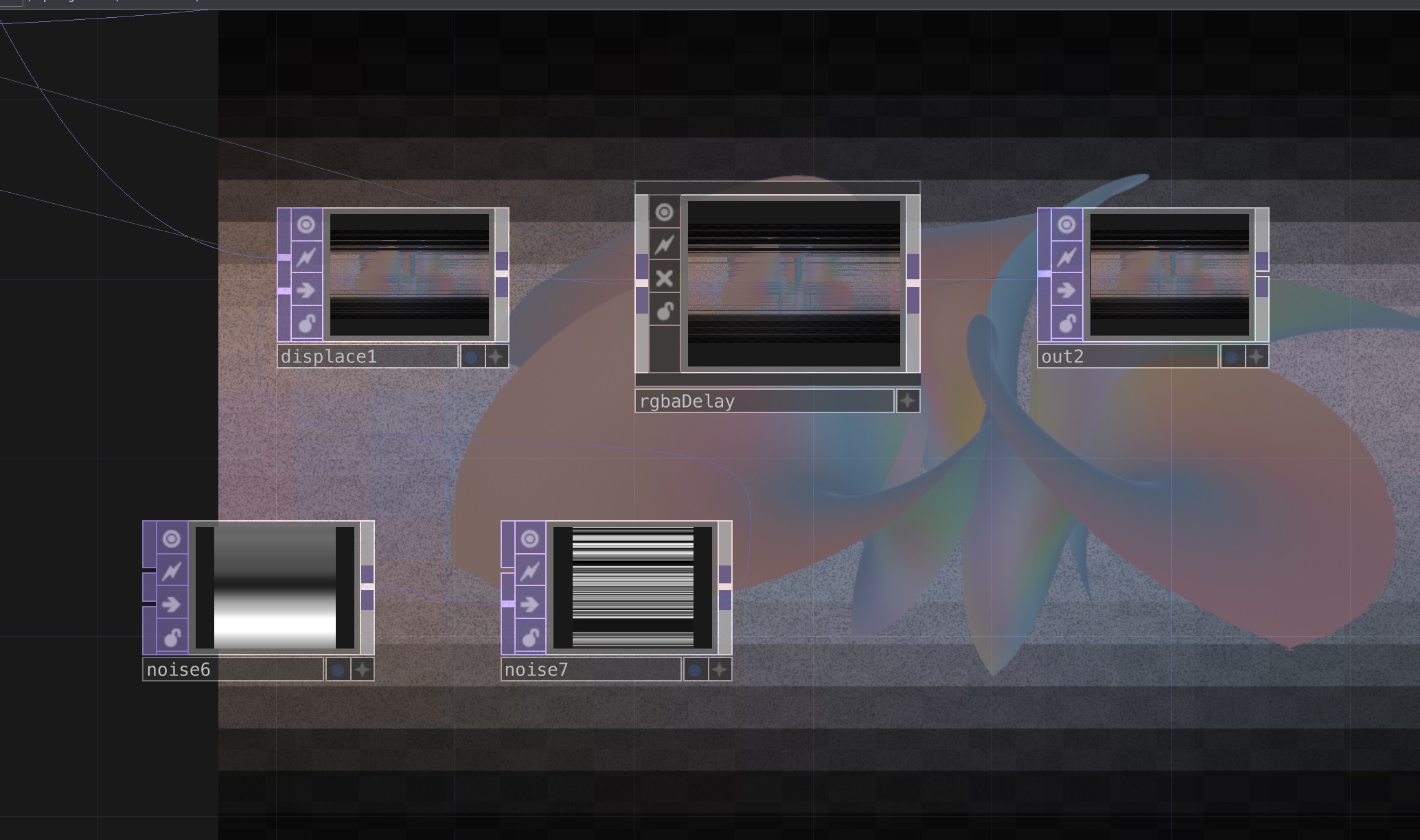
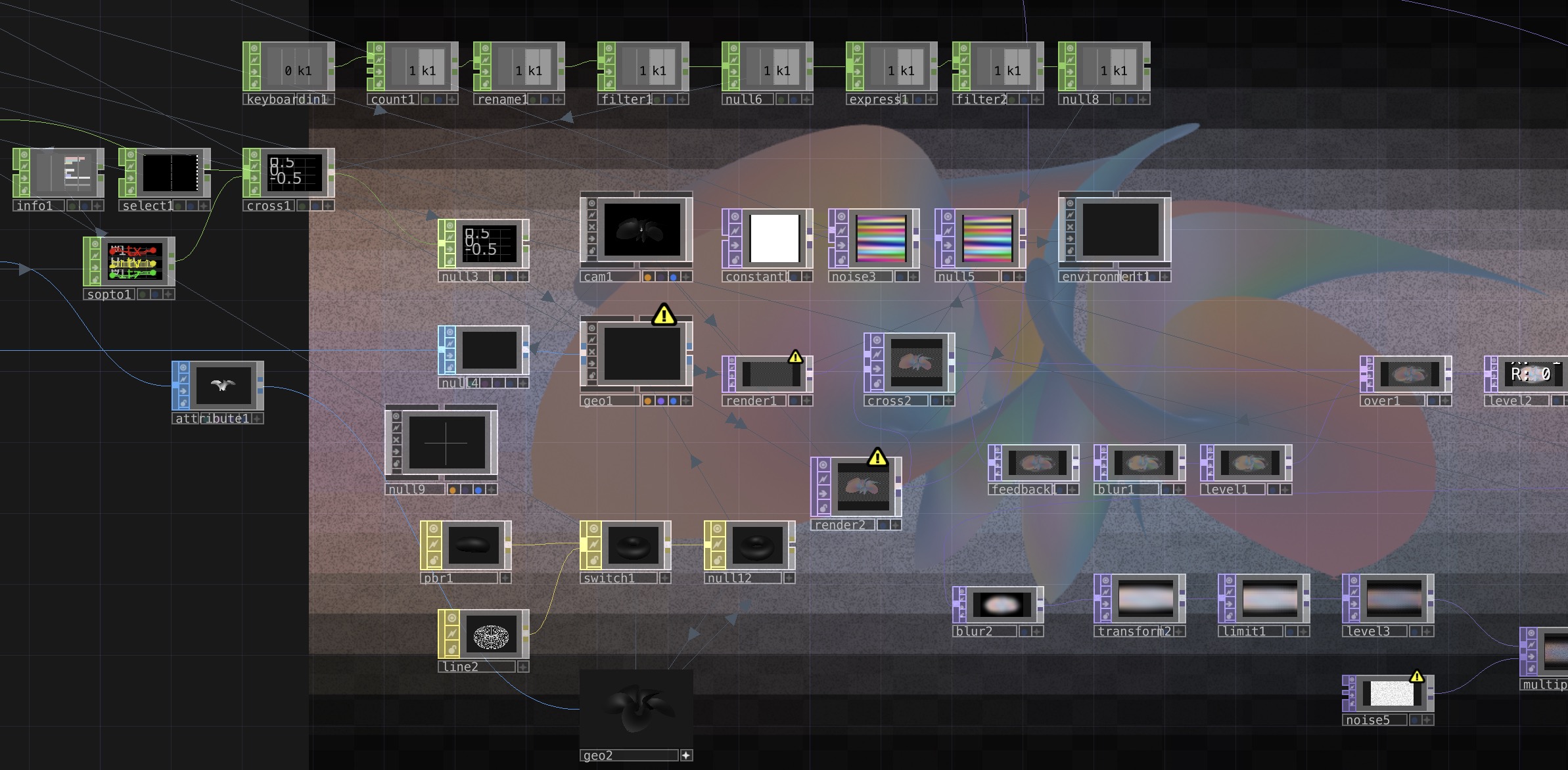
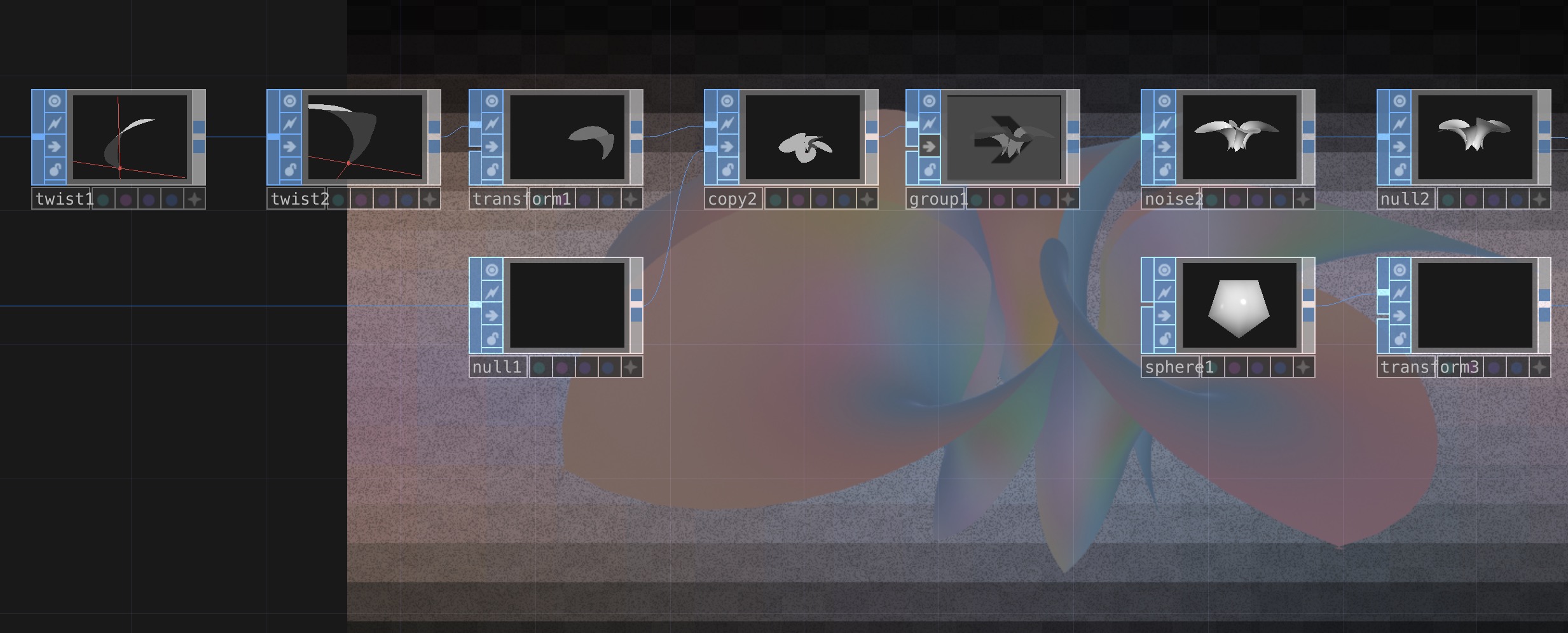
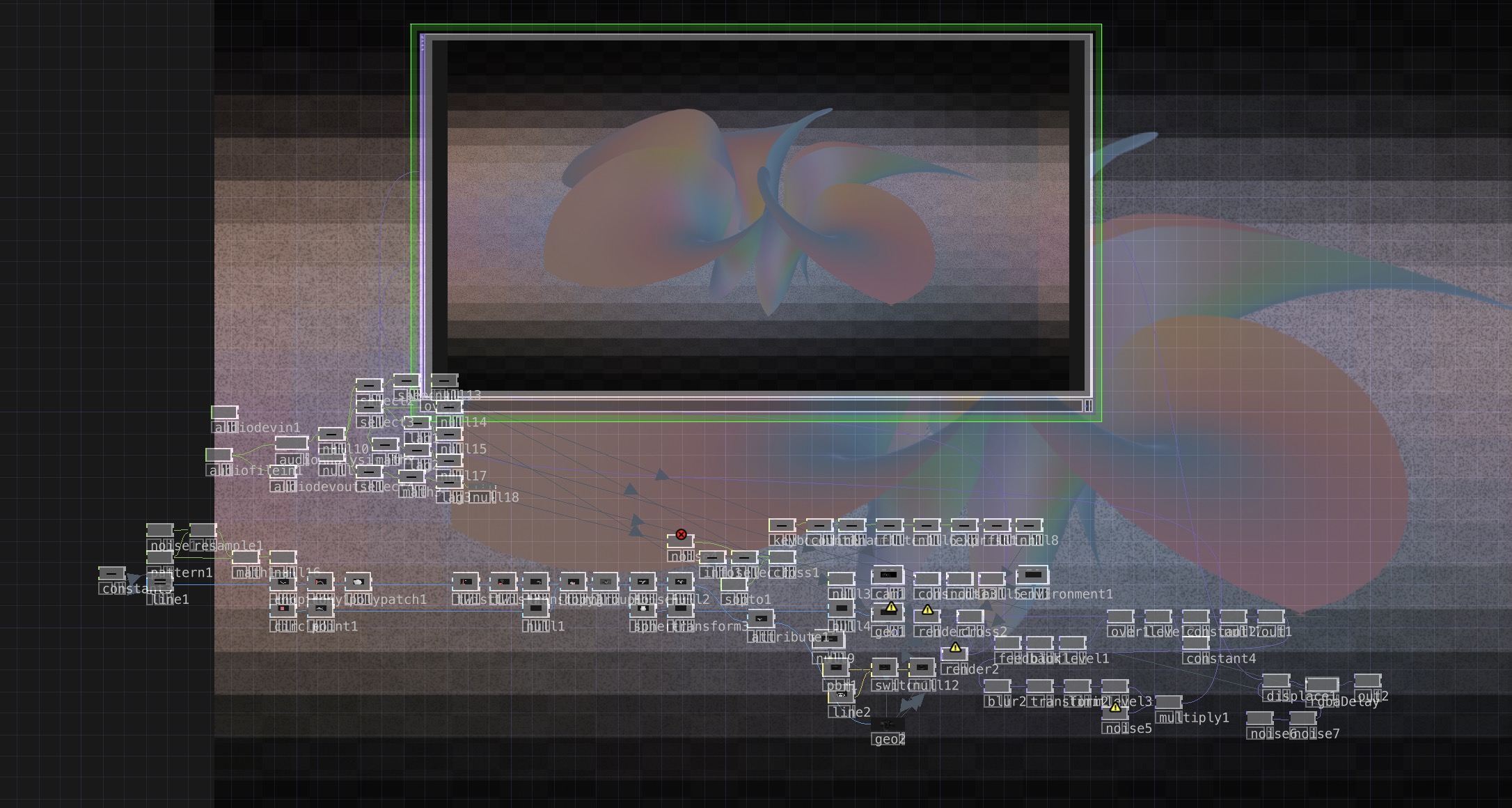

https://blogs.ed.ac.uk/dmsp-process23/2023/04/26/interactive/
Others Sounds(Yingxin Wu)
devices: Microphone Stand (Low) Schoeps - MK4 + CMC1L H6
Music(Yingxin Wu)
The music this time is also a very bold attempt. It was not done with traditional daw but with maxmsp which has never been used before. Because at the beginning, I wanted to use a max to control all processes. But then we had more and more ideas, and a max can no longer satisfy us.
Speaking of music, the innovation of changing the software (daw-max) first brought many difficulties. For example, the modulation of timbre took a lot of time. When combined, it becomes more abstract due to non-linear reasons
Pre for Sound(Yingxin Wu)
devices: Microphone Stand (Low) Schoeps - MK4 + CMC1L USB 2.0 - A to B XLR Male to XLR Female * 8 Genelec - 1031A - Active Monitor * 2 Genelec - 8030A - Speaker * 2 K&M - Mic Stand Mackie - ProFX8
Ideation: sketch
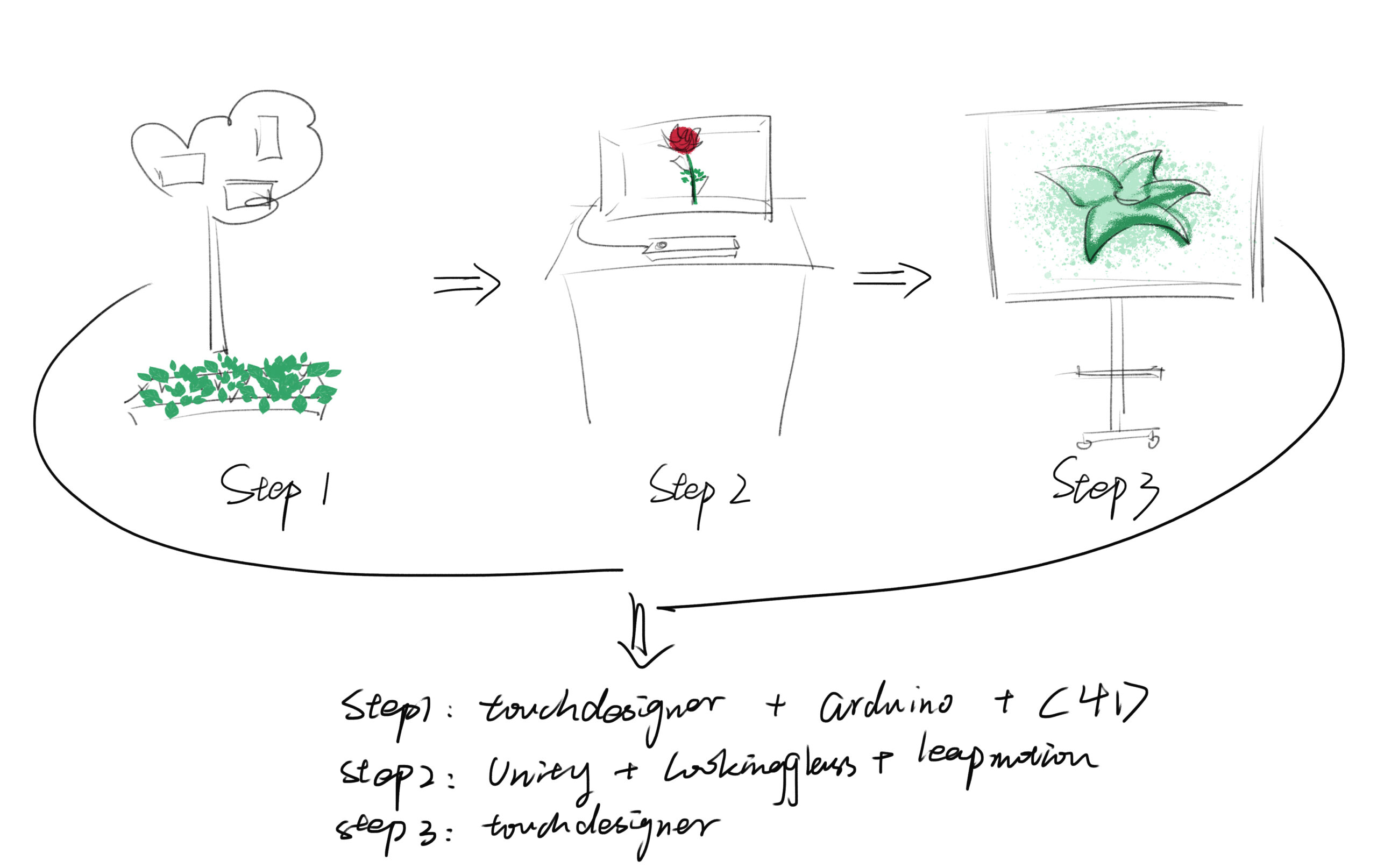
1. Step on the lawn and observe the plant growth process
When people walk into the venue and put their feet on the lawn, the video on the device in front of them will be triggered and played simultaneously.
2. Try to wave your hands
Use gestures to control different materials and states of flowers. Open hands: flowering; clapping hands: changing flower material; tilting hands: watering.
3. Feel the changes of Electronic Flower through drum changes
When people walk into the venue, their eyes will definitely be attracted by this beautiful visualized electronic flower. The flowers will dissipate as long as the sound or music. Among the changes are: coil change, blur change, rotation speed change, zoom in, color change.
After the exhibition, we made improvements to the previous design, including the improvement of the user’s tour of the exhibition, rich experience functions and integrity.
1.Vision (sketch/video/Unity)
Visual design plays a vital role in exhibition design, as it not only catches the viewer’s eye but also conveys information and emotion. Our design concept is to create an environment full of life and vitality by using C4D flower animation and Unity animation to guide the audience to start their thinking and exploration in the exhibition space.
We chose to use flowers as the theme of visual elements. By using C4D flower animation, we can present three different types, colours and shapes of flowers, so that the audience can feel the richness and diversity in nature. We can also express the flow and change of life through the dynamic movement and change of flowers.
In the exhibition space, we will also use Unity animations to create an environment that echoes the flower theme. We put flowers into Lookingglass, and the experience can explore different gestures to correspond to different flower changes. These design elements are strongly interactive to capture the attention and interest of the audience.
Group1—plant animation production 1.0(C4D)
Group1—plant animation production 2.0(C4D)
Group1—plant animation production 3.0(C4D)
2. Interaction (Arduino/ Lookingglass/ leap motion) (Boya Chen )
In the choice and design of interaction methods, we wanted to create interaction methods that gave real-time feedback and were relevant to the theme of the design, rather than just simple audio and video control.
STEP
1.Connect the Arduino board and pressure sensor: Connect the pressure sensor to the Arduino board, and then connect the Arduino board to the computer.

2.Write an Arduino program: Use the Arduino development tool to write a program that reads data from the pressure sensor and transmits the data to the computer.
3.Install Serial DAT: In TouchDesigner, install the Serial DAT component, which can receive data sent by the Arduino board.
4.Configure Serial DAT: In TouchDesigner, configure the Serial DAT component to communicate with the Arduino board. The serial port and baud rate parameters need to be specified.
5.Create a trigger: Use the CHOP component in TouchDesigner to create a trigger that can receive data sent by the Serial DAT component and convert the data into a signal that can be used to control the speed of video playback.
6.Control the speed of video playback: Use the Movie File In component in TouchDesigner to import a video file, and use the trigger to control the speed of video playback based on the data received from the pressure sensor.



Steps

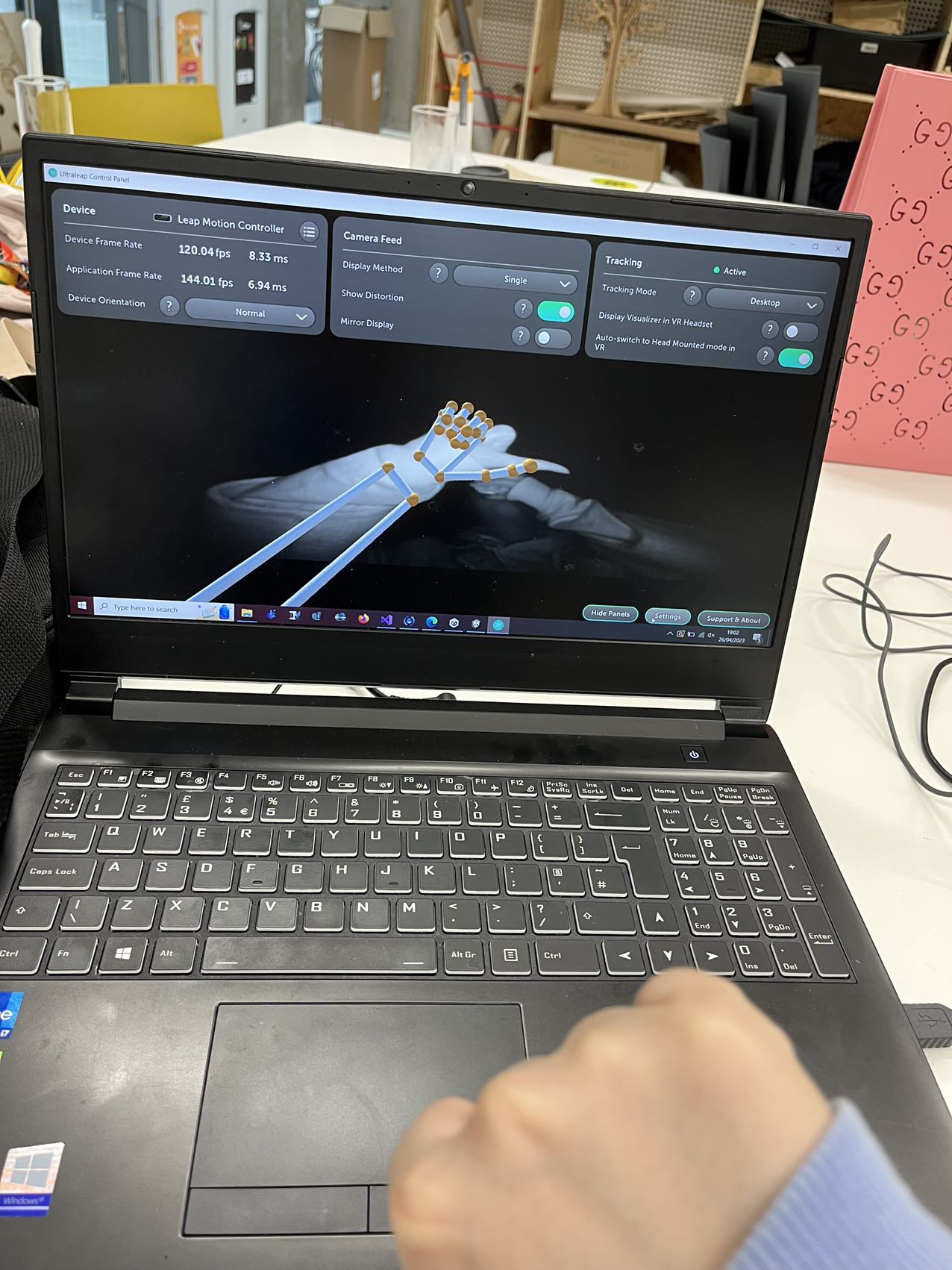

Collection of user experience feedback
1.“This is the first time I have participated in a plant-themed exhibition, and this exhibition has given me a deeper understanding of plants. I have never thought that there can be so many connections between people and plants. Now, I am beginning to realize that each There is also a close relationship between plants and humans. I also found the interactive parts in the exhibition very interesting, which was a great experience!”
2.“I find this exhibition very inspiring. It shows us the importance of plants in our lives and to reflect on the relationship between man and nature. I like the interactive experience in the exhibition, such as using lookingglass, and using different gestures to Flowers achieve different effects. It’s really interesting. So, I’m glad I participated in this exhibition, it gave me a deeper understanding of the relationship between nature and human beings.”
3.“I think the theme of this exhibition is very good. However, I still encountered some problems during the experience. For example, when I stepped on the lawn, the interactive device was not triggered in time, and the response was a bit slow, so I think I can continue to optimize it. Experience the process.”
4.“The visual effects and sound effects of this exhibition are very good. I feel that I am really in a plant world, and the various sounds in the exhibition make me feel that I am in a real environment, allowing people to understand It gave me a better understanding of the relationship between plants and nature, and also made me feel that I need to pay more attention to our natural environment. Overall, it was a very memorable experience.”
This innovative exploration of potential plant mutations and future transformations serves as a testament to the power of interdisciplinary collaboration and the limitless potential of human-AI partnerships. By harnessing the capabilities of advanced AI tools and working in synergy, we have successfully created an engaging and thought-provoking exhibition that invites audiences to ponder the fascinating intricacies of the natural world.
https://github.com/ultraleap/UnityPlugin/releases/tag/com.ultraleap.tracking/6.6.0
https://docs.lookingglassfactory.com/developer-tools/unity
https://docs.lookingglassfactory.com/developer-tools/unity/prefabs#holoplay-capture
https://wiki.seeedstudio.com/Grove-Touch_Sensor/
https://developer.leapmotion.com/unity
https://www.nts.org.uk/stories/the-thistle-scotlands-national-flower
https://1.share.photo.xuite.net/ngcallra/1148daa/16615727/894216827_m.jpg
https://www.bilibili.com/video/BV1he4y1B79Z
https://cowtransfer.com/s/725c23cf2d7f47
https://www.picturethisai.com/image-handle/website_cmsname/image/1080/154238468984143882.jpeg?x-oss-process=image/format,webp/resize,s_422&v=1.0
https://www.bilibili.com/video/BV1rr4y1Q714
https://www.bilibili.com/video/BV1he4y1B79Z
https://www.haohua.com/upload/image/2019-08/04/27b56_41fd.jpg
We have optimised the design and re-arranged the scenery.

Tidy up the black cloth, spread the black cloth on the ground, make the ground clean and tidy effect better.
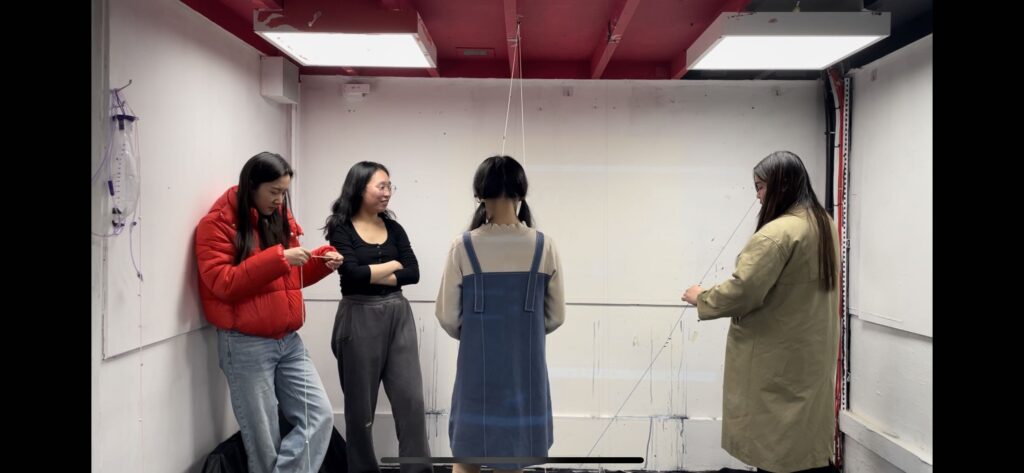
In order to increase the interaction between the audience and the water. Together, thread the bell onto the thread and straighten the silk thread. There were two strands of silk hanging on the water, wrapped around them. The viewer can pull the threads at will, creating sounds and vibrations that affect the ripples in the water. Add fun and audience experience sense.
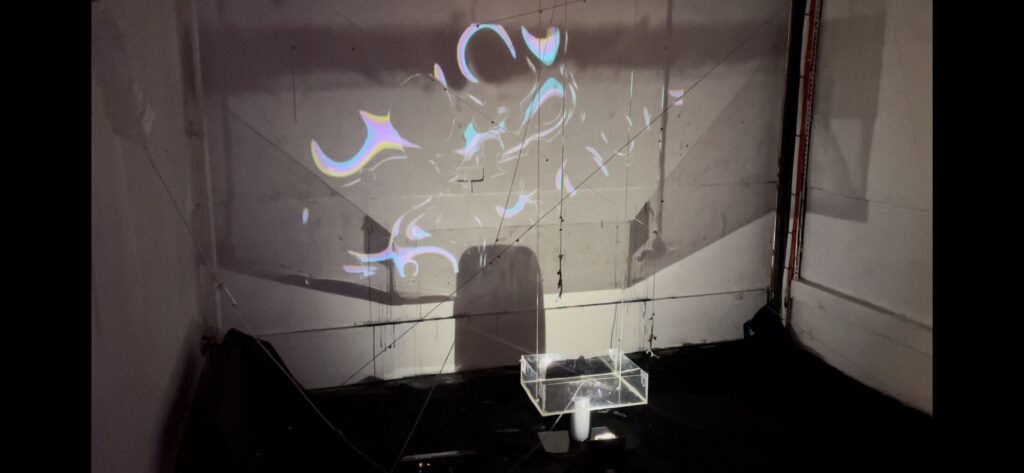
Rope up the tank. The sound is placed under the tank to vibrate, so as to produce a richer water wave effect.
Test Touchdesigner gesture recognition.
After the show was finished, we made some more adjustments by analysing the feedback. For the music, I added two melodies, a piano piece and an ambient piece for the video clip background and the interview background music. To make the music more amplified, adjustments were made to MAX,
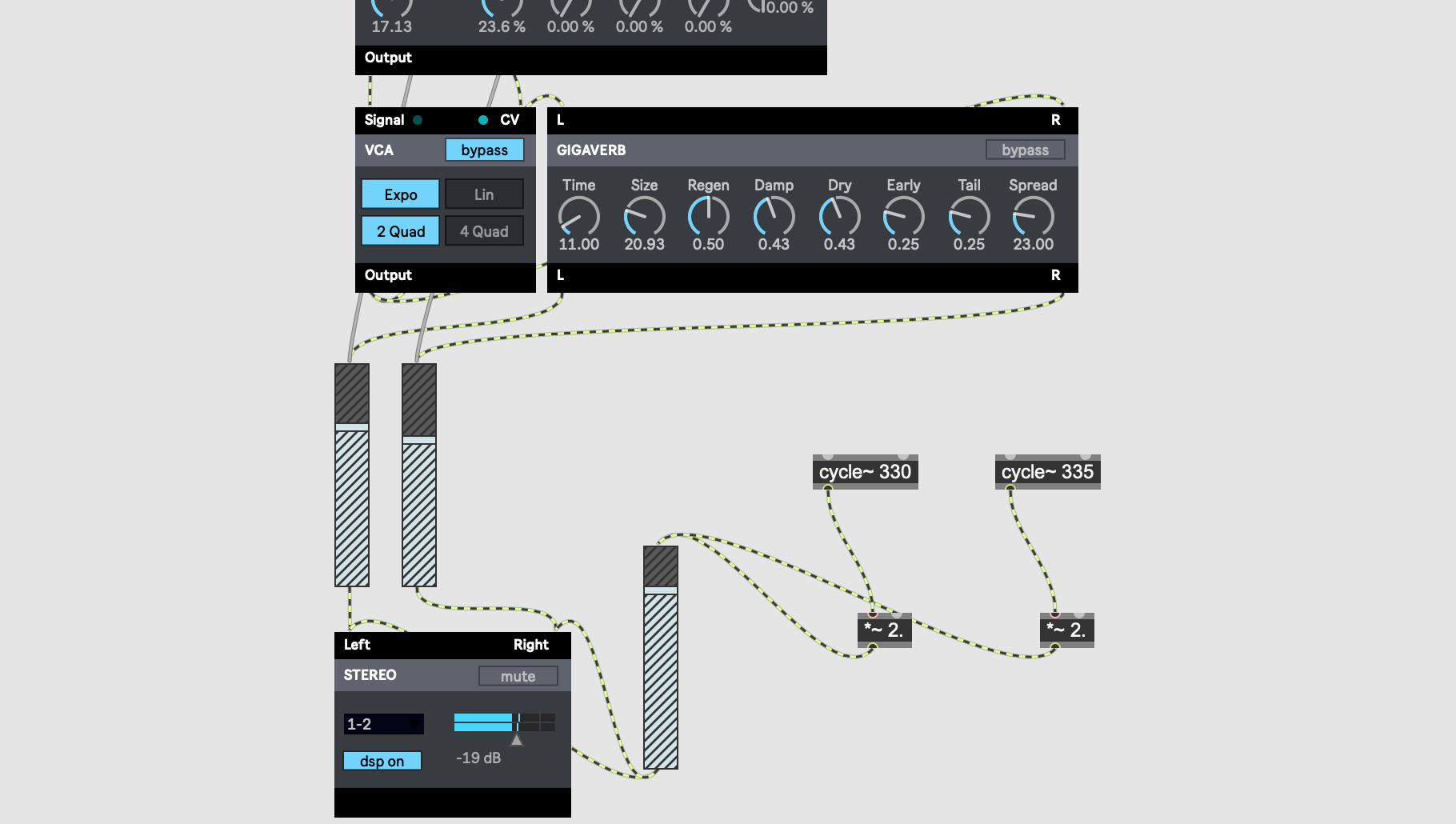 adding the amplitude of the music to make the connecting water tank ripples more visible and the changes in the water tank ripples more distinct with the rhythm of the music.
adding the amplitude of the music to make the connecting water tank ripples more visible and the changes in the water tank ripples more distinct with the rhythm of the music.

Each beat of the music brings about an ebb and flow of the water. Combined with the images we have made, it allows the audience to be immersed in the beautiful music and enjoy the beautiful blend of water and music. As the climax of the music gradually approaches, the characters on the projector run faster and faster, and the amplitude of the water tank ripples increases, creating a beautiful wave of water as if it were an artistic painting. People followed the rhythm of the music and felt the beauty of it all as if they were immersed in a beautiful dream world. In this live experience, the effect of the images is not only created by the vibrations and intensity of the music but also changes according to the sound made by the audience through the microphone radio. Participants can shout, jump, snap their fingers, clap their hands, sing and other interactive ways to make the images change even more. This unique way of interacting with sound creates an overwhelmingly exciting, entertaining, and creative atmosphere. Finally, when the music slowly ended and the water tank ripples slowly calmed down, the whole space returned to peace and calm. This live experience gave them a musical and visual treat and a unique experience and enlightenment in their minds.
The content of this blog consists of the work of Rudan, Jin, Yuan and Jaela.

Tidy up the black cloth, spread the black cloth on the ground, make the ground clean and tidy effect better.

In order to increase the interaction between the audience and the water. Together, thread the bell onto the thread and straighten the silk thread. There were two strands of silk hanging on the water, wrapped around them. The viewer can pull the threads at will, creating sounds and vibrations that affect the ripples in the water. Add fun and audience experience sense.

Rope up the tank. The sound is placed under the tank to vibrate, so as to produce a richer water wave effect.
Test Touchdesigner gesture recognition.
Based on our meeting on April 19, we decided to make the installation more interactive and playable. I find some video tutorials of Touch Designer with Kinect and Leap Motion on Youtube. Since the Leap Motion is not available from the university, I booked the Kinect camera from the music store.
From my perspective, the theme or style needs to keep consistent with our project, which means it is expected to be related to water and water-ish stuff. Therefore, I prefer creating water painting effects through the feedback function and the slope TOP.
Tutorial Link: Water painting Effect
Water Painting Part Effect:
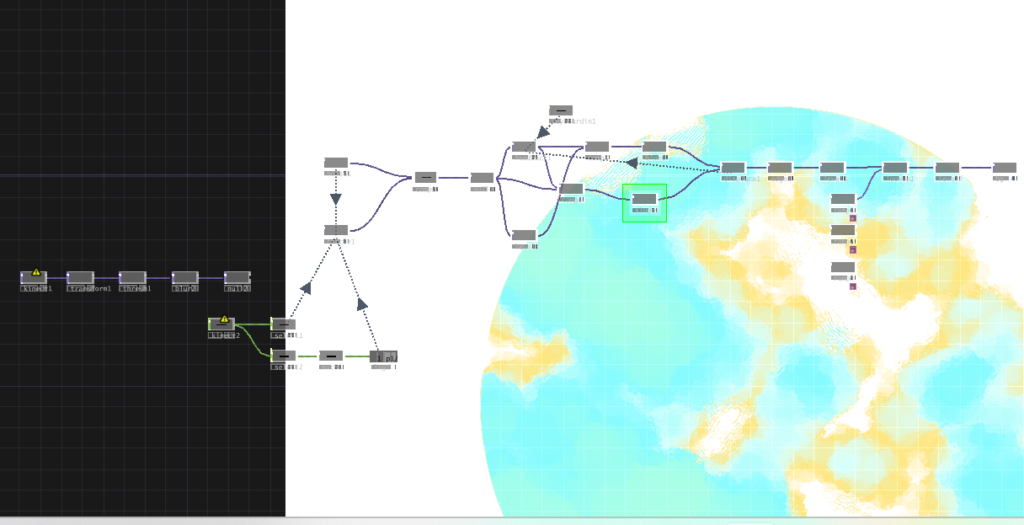
Kinect Camera Connection
I use kinect v1 TOP and kinect CHOP of panel and selector to get the left and right hand data from camera. In addition, I drag the data as a chop reference to the position of the water painting circle.
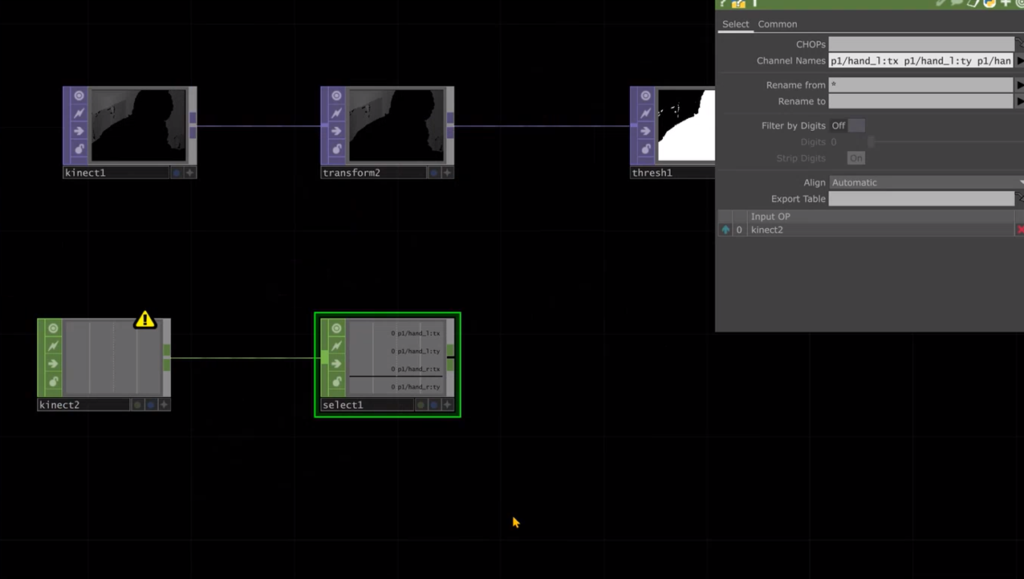
And then I combine this part with the sound visualization. Now the sound visualization part would appear when the part is covered by the circle.
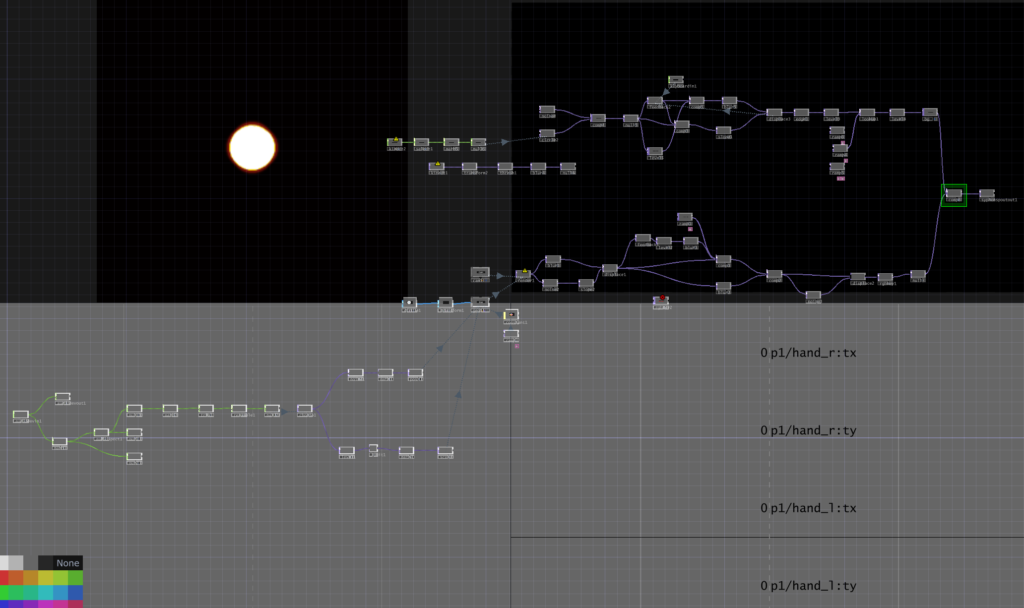
According to Philly's and Jules's feedback on our presentation and exhibition at ECA Main Building E15A on April 19, I noted them and some corresponding ideas and held a meeting with my team members.
Feedback Record:
From Jules:
The sound generated by Maxmsp is an active feedback process. The waves can travel across the water’s surface and hit the other end, and then it started to come back again.
- The sound is expected to be louder to avoid being broken up. The speaker is not big enough to produce the high frequency and create the vibration. Also, the interaction way of clapping or other ways to make noise is not un-stopping. Try to actively use feedback to make it stable.
- Refer to the Chandni pattern.
- Create sound or fans to create ripples on the surface, and also make the strings move.
- Animate the videos, make the character moving from one screen to the other. The person can walk around, disappear and so on. Merge these three screens.
- The music feels like a sci fi music rather than a positive, pleasant atmosphere. Add a bit variety.
From Philly:
- Working in a slightly bigger space that was more nevigable, allowing the audiences to walk around. Present this piece as a more walkable and immersive installation.
- Place objects or interacive elements within the space.
- The video materials did not effectively communicate the themes of the piece. Create significantly more variety and use some more abstract imagery.
- The touch designer aspect needs some more variation.
- More proposed theme in video content, music evolution or visual evolution.
I summarized the feedback and categorized them into several parts given by Jules and Philly, and organized a meeting on April 19 to discuss the update plan.
I found some references as follow:
After my discussion with Jin, we decided to split up. She went off to test whether the new effects would work and I continued to refine the current design with the other members of the team. Meanwhile, I juggled preparing new material as well as editing the original video and refining the video of the characters walking around. I also took on the job of editing the final video.
Abstract speech visualisation – touchdesigner tutorial 45 (2021) YouTube. YouTube. Available at: https://www.youtube.com/watch?v=1FgJ842dyr4 (Accessed: April 27, 2023).
Touchdesigner Tutorial edge feedback (2021) YouTube. YouTube. Available at: https://www.youtube.com/watch?v=hve2UbKgJ9s (Accessed: April 27, 2023).